The Faroe Islands are a small cluster of self-governing islands located between Iceland and Norway.
It’s a destination that not too many tourists visit, but its quaint towns and awe-inspiring cliffs are something out of a fairytale, and the three days I spent here in the summer of 2022 were an unforgettable highlight of my recent travels.
Here are 10 tips for your first visit to the Faroe Islands to help you experience the very same magic that I did.
In This Post
- 1. Walk Around Tórshavn
- 2. Drive Around a Lot
- 3. Hike to the Kallurin Lighthouse
- 4. See Cliffs and Waterfalls Like Nowhere Else
- 5. Explore the Picturesque Villages
- 6. Go for a Helicopter Ride
- 7. Take a Day Out on the Ferries and Buses
- 8. Experience the Humble Hospitality of the Faroese
- 9. Stay at the Hilton Garden Inn
- 10. Spot Puffins
- Conclusion
1. Walk Around Tórshavn
Your journey to the Faroe Islands will most likely be centred around Tórshavn, the small capital of this tiny island country.
As one of the smallest capital cities in the world, Tórshavn is very easily navigable by foot. Exploring the charming city centre area surrounding the marina is a great way to get a first taste of what the Faroe Islands have to offer.
Tórshavn’s central area feels like a miniature version of Nyhavn in Copenhagen – the capital of the Faroe Islands’ sovereign parent, the Kingdom of Denmark – with its colourful buildings surrounded by the boats on the sea.
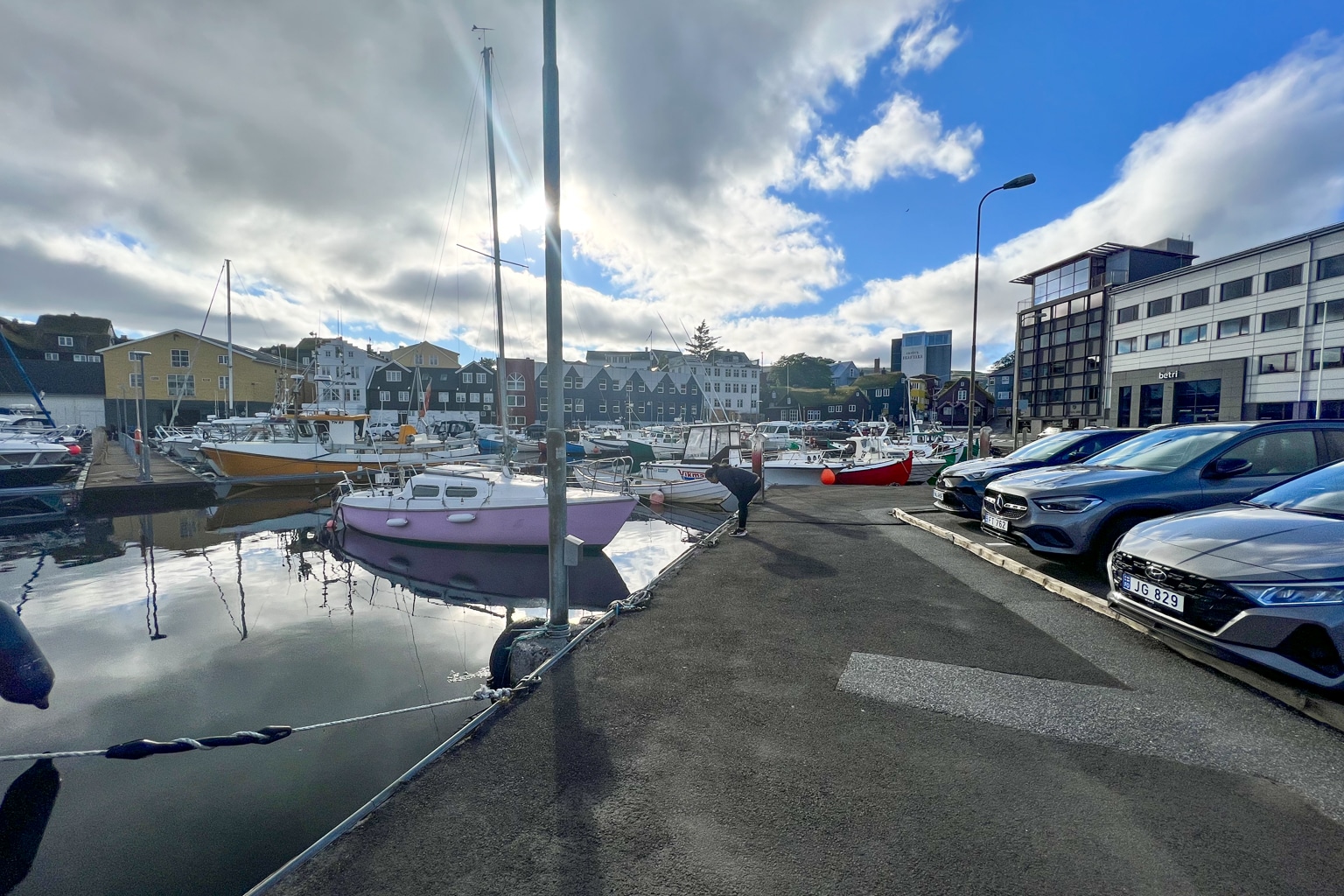
The skyline of this tiny settlement is fascinating to look at, and we enjoyed soaking in all of the interesting buildings that we came across.
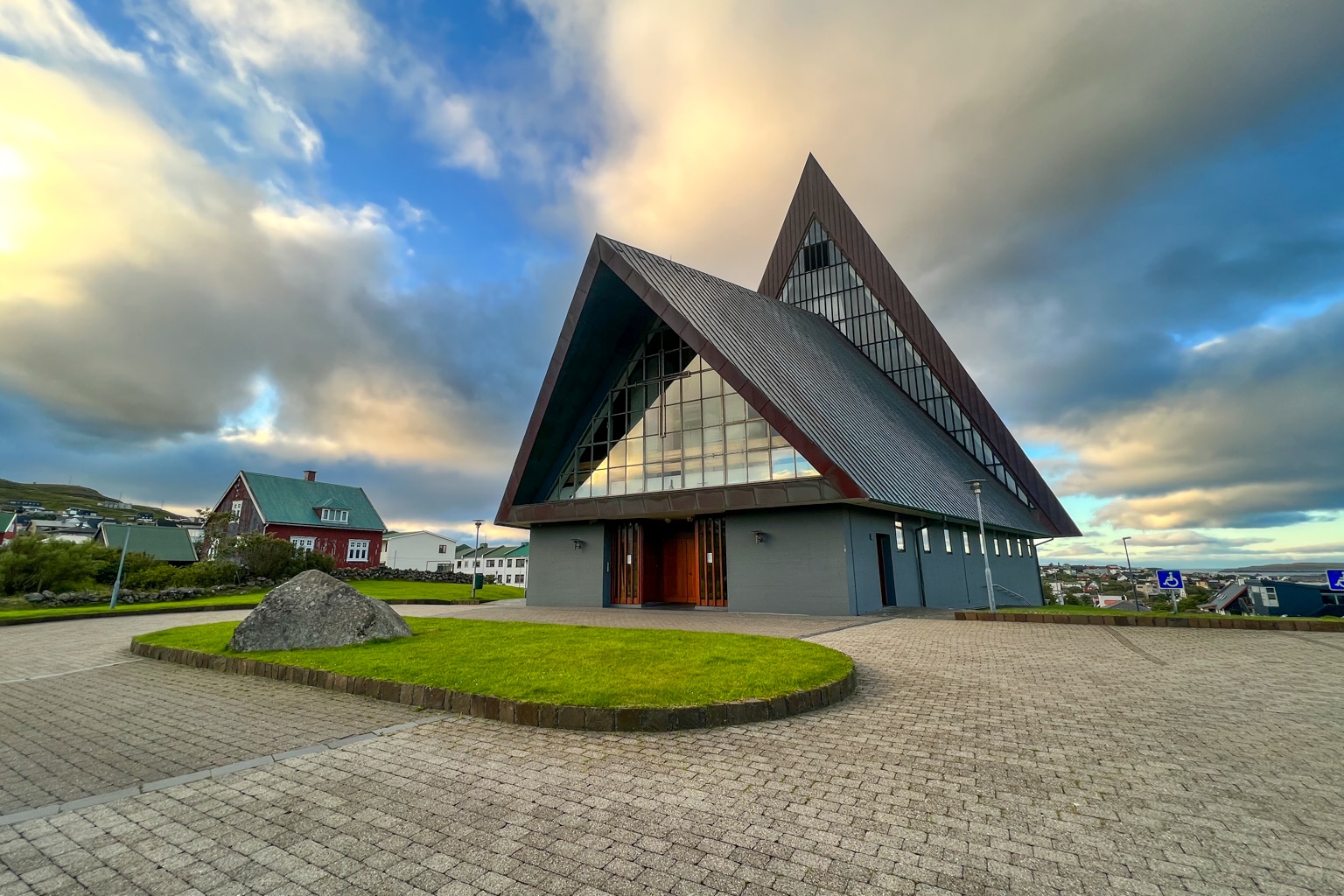
Although Tórshavn is small, it boasts a surprisingly multicultural dining scene. We had some tasty Thai food during our time in town, as well as a delicious burger at HAPS, a local burger joint.
[foogallery id=”71112″]
2. Drive Around a Lot
Travelling by car is the primary method of getting around and exploring all 18 of the Faroe Islands.
Once you’ve gotten your first glimpse in Tórshavn, you’ll want to drive around a lot so you can visit the neighbouring islands, take in the amazing scenery, and appreciate everything that the archipelago has to offer.
I’d definitely recommend picking up a car rental upon arrival at Vágar Airport. In our case, we had actually booked a car with Budget, but upon walking into the car rental centre, we stopped by one of the local car rental companies called CarRent.fo and asked if they could beat Budget’s price.
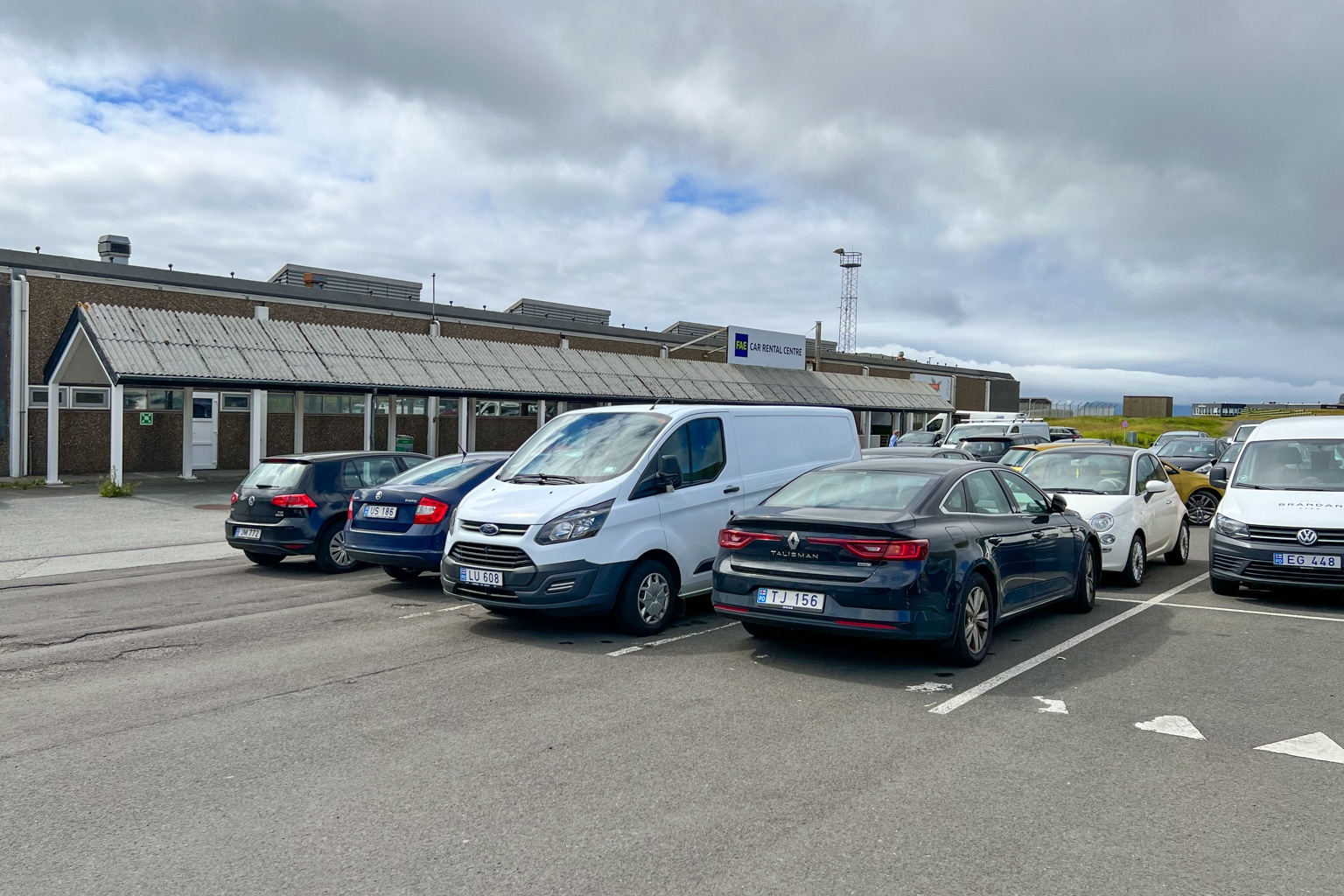
They did so by about 100 Danish krone, so if you’re renting a car, you should check with a local company, as it might be a cheaper option – and it’s always nice to support local businesses!
Most stretches of the main series of islands – Vágar, Streymoy, and Eysturoy – are all connected by road. Many destinations across these islands can be reached from Tórshavn within about an hour, so while you’ll want to plan for some driving time, it won’t be too time-consuming.
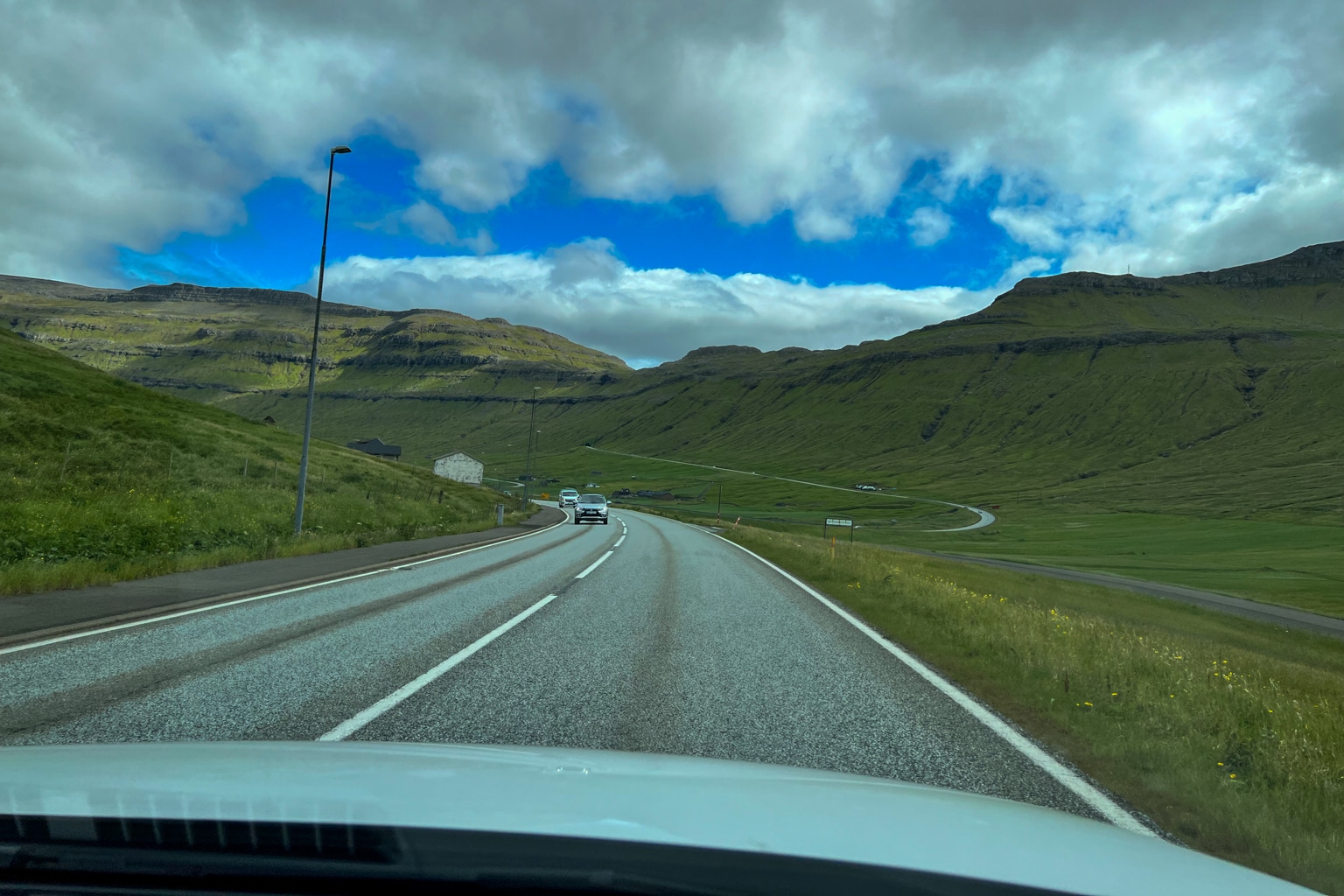
Since the early 2000s, the Faroe Islands have been building a series of advanced underground tunnels. Right now, there are three such tunnels:
- Vágatunnilin connects Vágar and Streymoy
- Eysturoyartunnilin connects Streymoy and Eysturoy (including the world’s only undersea roundabout, which is very much an experience in itself)
- Norðoyatunnilin connects Eysturoy and Borðoy
By 2023, there should be another tunnel built all the way to the southernmost island of Suðuroy as well.
I found the undersea tunnel network to be highly impressive, and there was a bizarre sense of juxtaposition between the remoteness of the Faroe Islands and the advanced infrastructure of the place, as we’ll discuss later.
3. Hike to the Kallurin Lighthouse
There are a few destinations in the outer reaches of the Faroe Islands that are absolutely worth checking out.
For example, the Kallurin Lighthouse, located at the northernmost tip of the island of Kalsoy, is definitely a must-see on your trip to the Faroe Islands.
The hike to the lighthouse is downright breathtaking, and was the single best hike I’ve been on in my life.
Kalsoy is one of the many very thinly shaped islands in the northeast of the territory. To get there, you’ll need to drive to the second-largest city of Klaksvík, situated on the island of Borðoy. From there, you take a ferry to access Kalsoy, as there are no roads that connect directly to it.
It’s possible to drive onto the ferry, but there are a limited number of spots for vehicles, so you’ll need to arrive early to line up for a spot. Alternatively, you can also visit the lighthouse on foot.
After you arrive by ferry, you’ll need to drive or take a bus from Kalsoy’s southern ferry port of Syðradalur all the way to the northernmost village of Trøllanes. From there, you embark on about a 45-minute hike across a pure-green sloping hill until you get to the lighthouse.
As you proceed across this sloped hill, you really have no sense at all of the stunning views that are about to greet you – until the hike culminates at the hill’s highest point, where you’re met with a sheer cliff down to the ocean far below.
Only once you get to the very top of the hill and the lighthouse itself, you’ll turn around and suddenly witness one of the most beautiful natural formations that you’ll ever encounter.
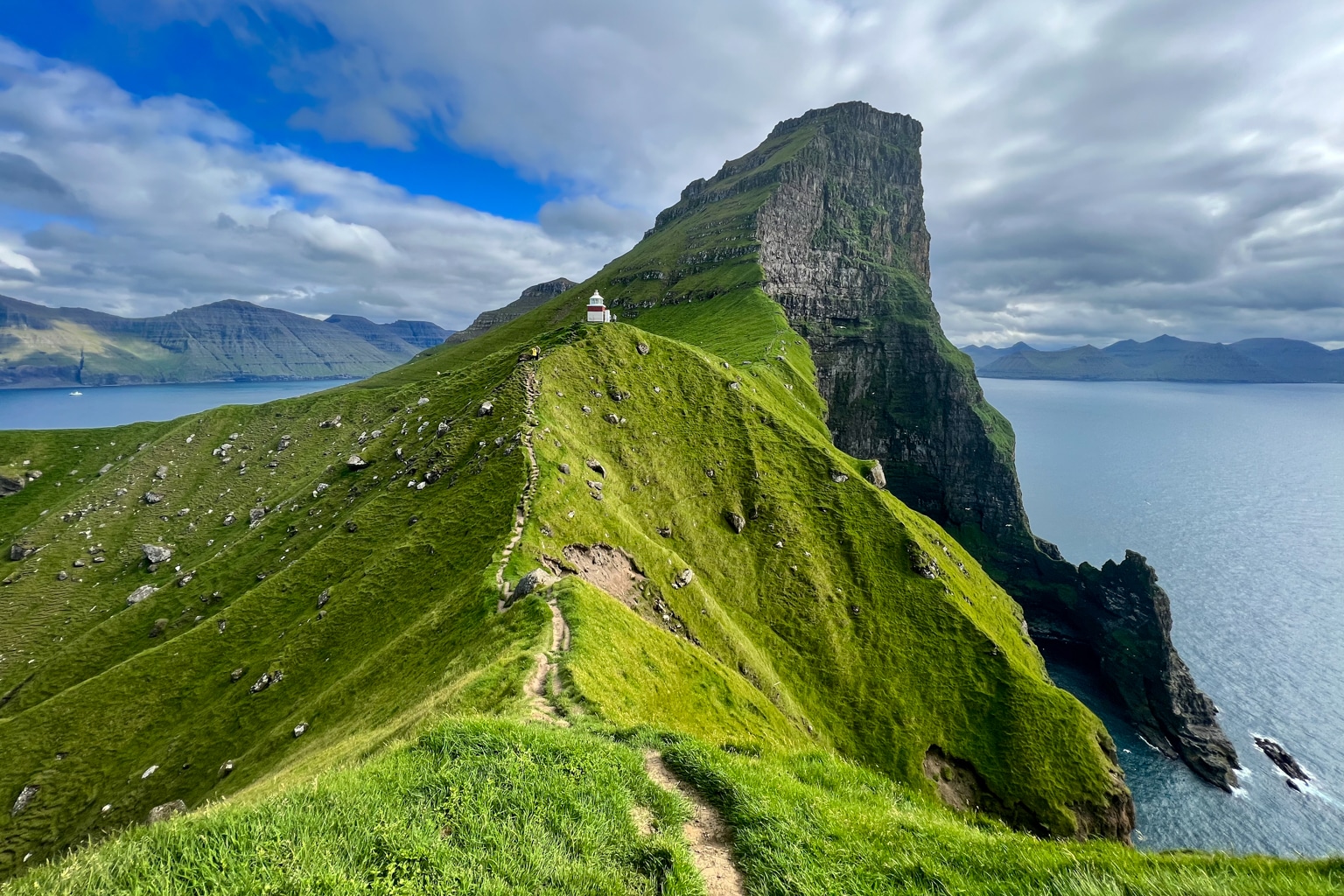
From the lighthouse, you can hike down and then head up to an outcrop at the very northern tip of Kalsoy. Looking back across this thin island, seeing bodies of water on either side, is simply a sight to behold.
One of the reasons I’d recommend driving your own vehicle up here, if you can, is so you can complete the hike on your own schedule. You won’t want to be pressed for time, worrying about catching the bus for the return journey.
Instead, plan to stay here for hours in order to simply absorb the stunning views all around you. No other view that I’ve experienced so far quite compares to it.
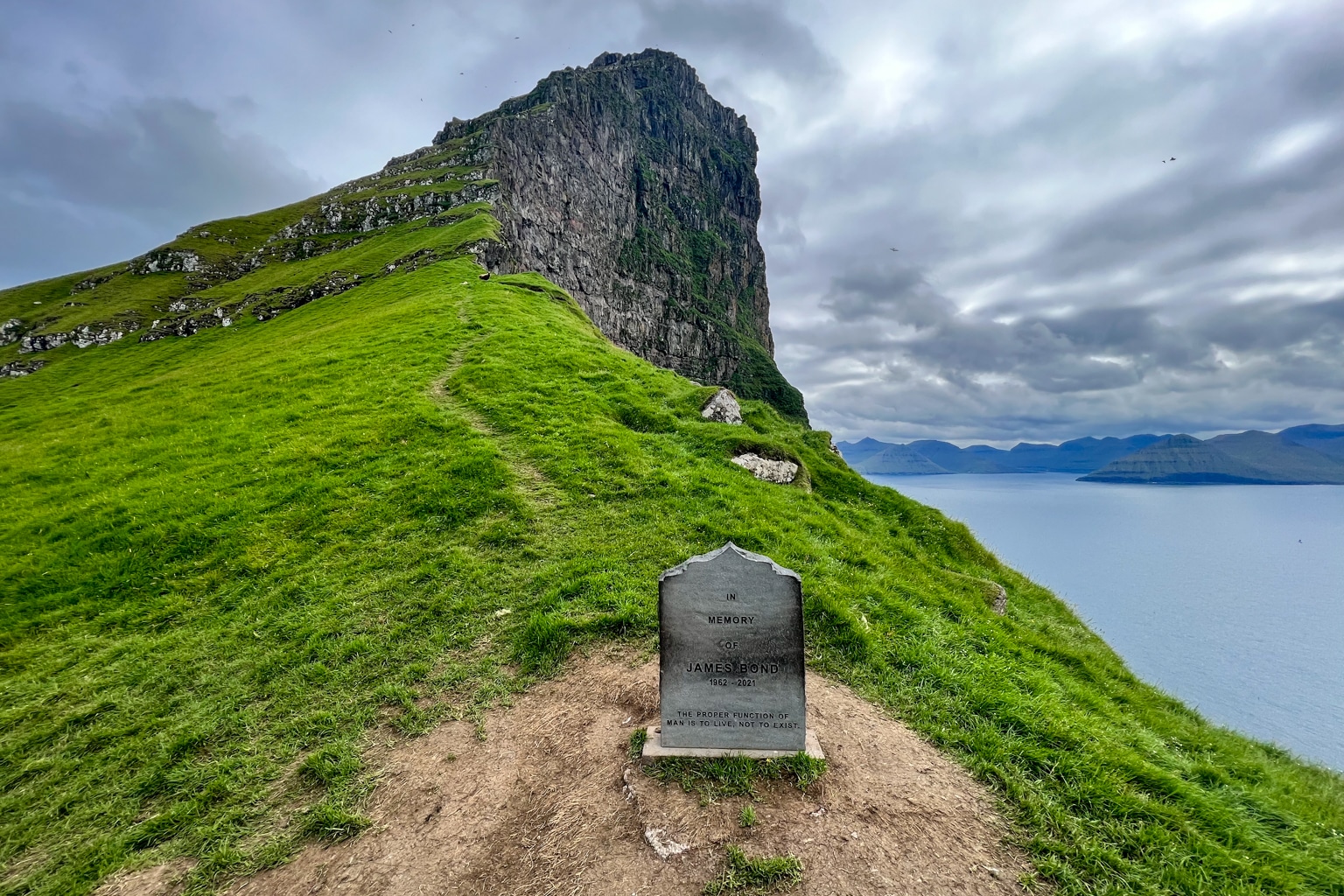
4. See Cliffs and Waterfalls Like Nowhere Else
The Faroe Islands are all about natural scenery, thanks to their dramatic rugged cliffs, storm-lashed coasts, and awe-inspiring waterfalls. Here are a few of the highlights among the islands’ many natural sights to behold.
Located on Vágar, Múlafossur Waterfall is the only waterfall I’ve ever seen that cascades directly into the ocean. I stood absolutely transfixed as I watched this incredible natural phenomenon take place.
I couldn’t help but mull over the fact that for thousands of years before I was here, and for thousands of years after I’m gone, Múlafossur will continue to drain into the Atlantic Ocean with such striking simplicity.

Múlafossur is found at the western side of Vágar, which is also where the airport is located. Thus, a trip out here is a natural stop to make either right after you arrive or just before you depart from Vágar.
On the same island, and only five minutes from the airport, is the Trælanípa cliff. You can hike around a rather unique lake called Leitisvatn, and you’ll eventually be treated to an outstanding view at the top of this hike.
Quite remarkbly, the Leitisvatn lake also drains directly into the sea, albeit less dramatically than Múlafossur. However, the real point of interest here is a cliff called Trælanípa, where with good weather, you can find a view of Leitisvatn that resembles an optical illusion.
Since Trælanípa is situated high above the lake, which itself is above sea level, you can get some pretty mind-bending views of the scenery here. The lake appears as though it’s actually floating above the sea, as though it were “a lake in the sky”.
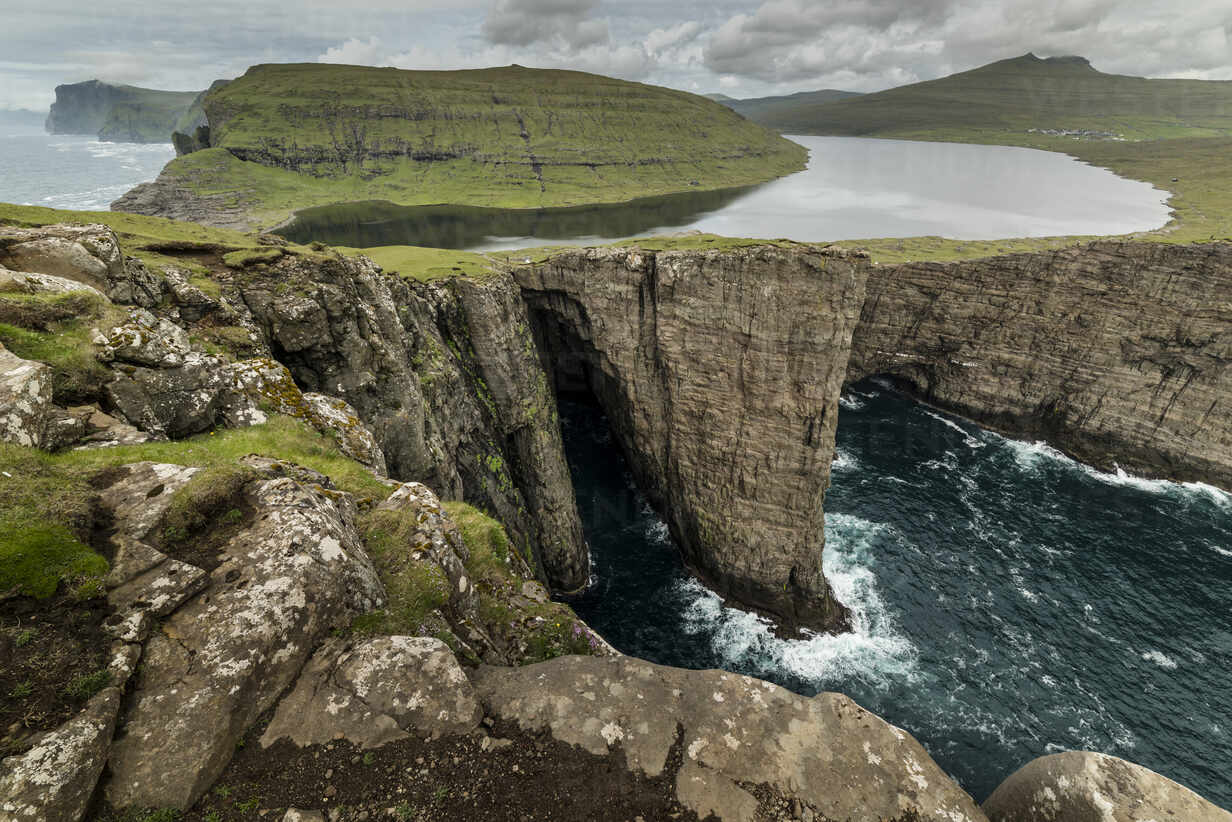
On our particular visit, it was quite windy and foggy, so we didn’t actually get to see the incredible views. Still, the mirror-like surface of the lake itself was quite beautiful.
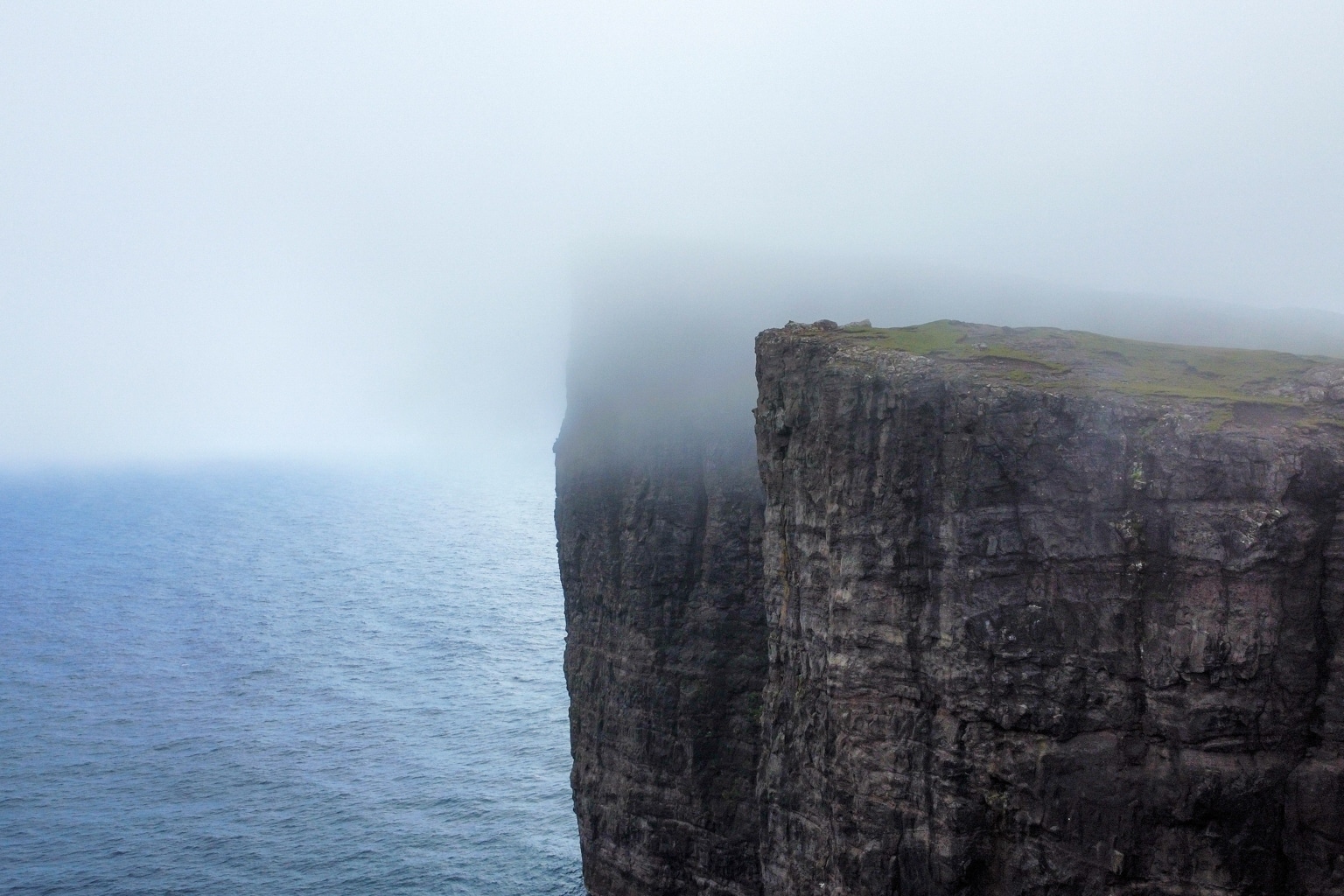
Also, if you’re tempted to fly a drone to capture the views out here in the Faroe Islands, make sure to be careful of the windy weather.
In my case, my DJI Mini 2 was sadly lost to the winds, having been taken down by a strong draft of upwardly wind arising from a cliff here at Trælanípa.
In addition to these two dramatic sights here at Vágar, you’ll find unique and beautiful cliffsides all over the Faroe Islands, which are well worth your time to admire.
5. Explore the Picturesque Villages
Besides the capital of Tórshavn and some of the bigger cities like Klaksvík and Runavík, all the other settlements here in the Faroe Islands are tiny villages of up to 50 to 100 people at most – and often with even fewer inhabitants than that, such as only 10 or 20 people.
With distinctive colourful buildings and a uniquely-designed church in each one, the Faroese villages look right out of a storybook, as though they’re trapped in time and haven’t caught up with the modern era.
A few highlights to explore include Saksun, which is located at the end of a long single-lane road on the main island of Streymoy. From Saksun, you can hike down to a black sand beach, where you can actually get up close and personal with the ocean as the tide swarms around the beach.
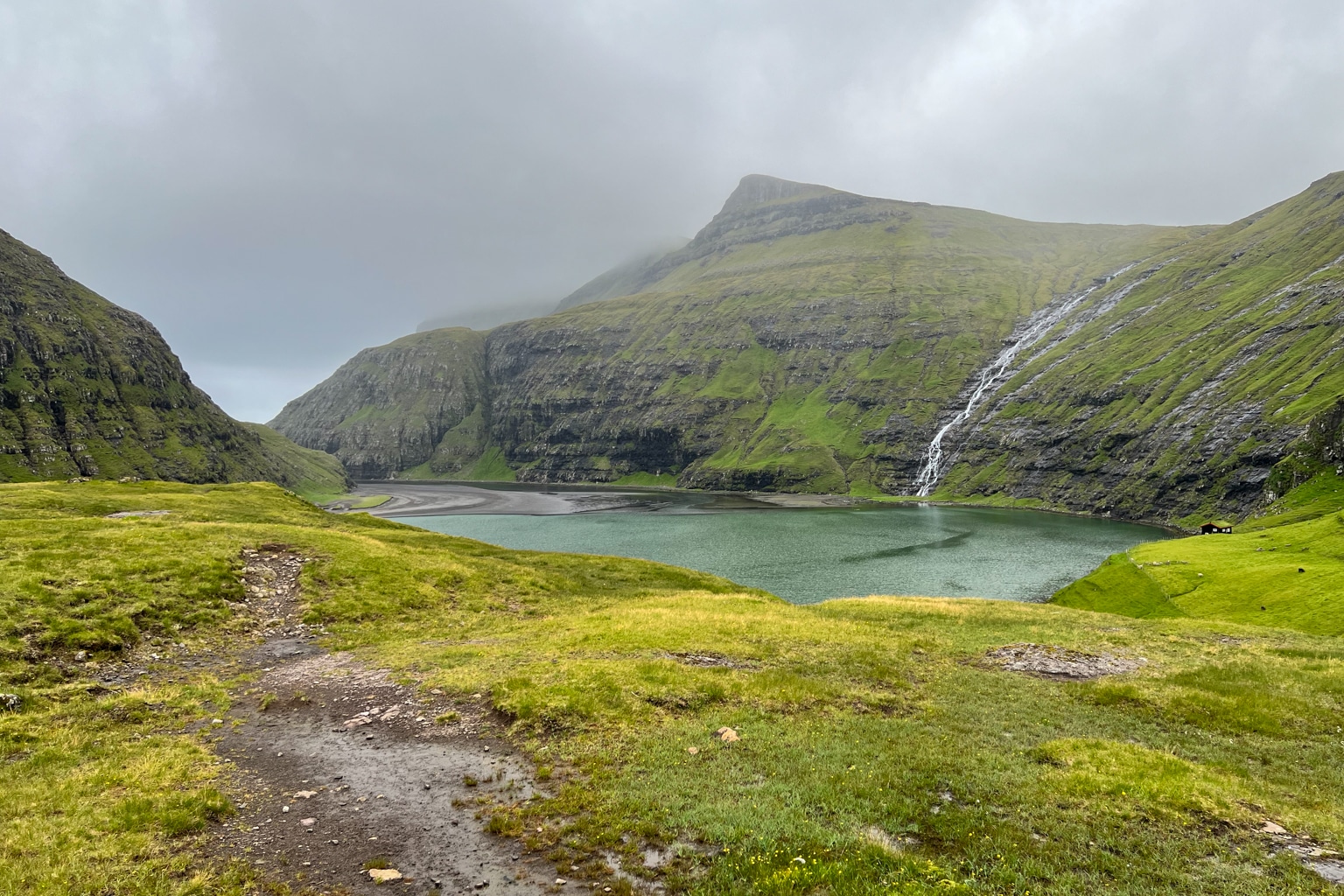
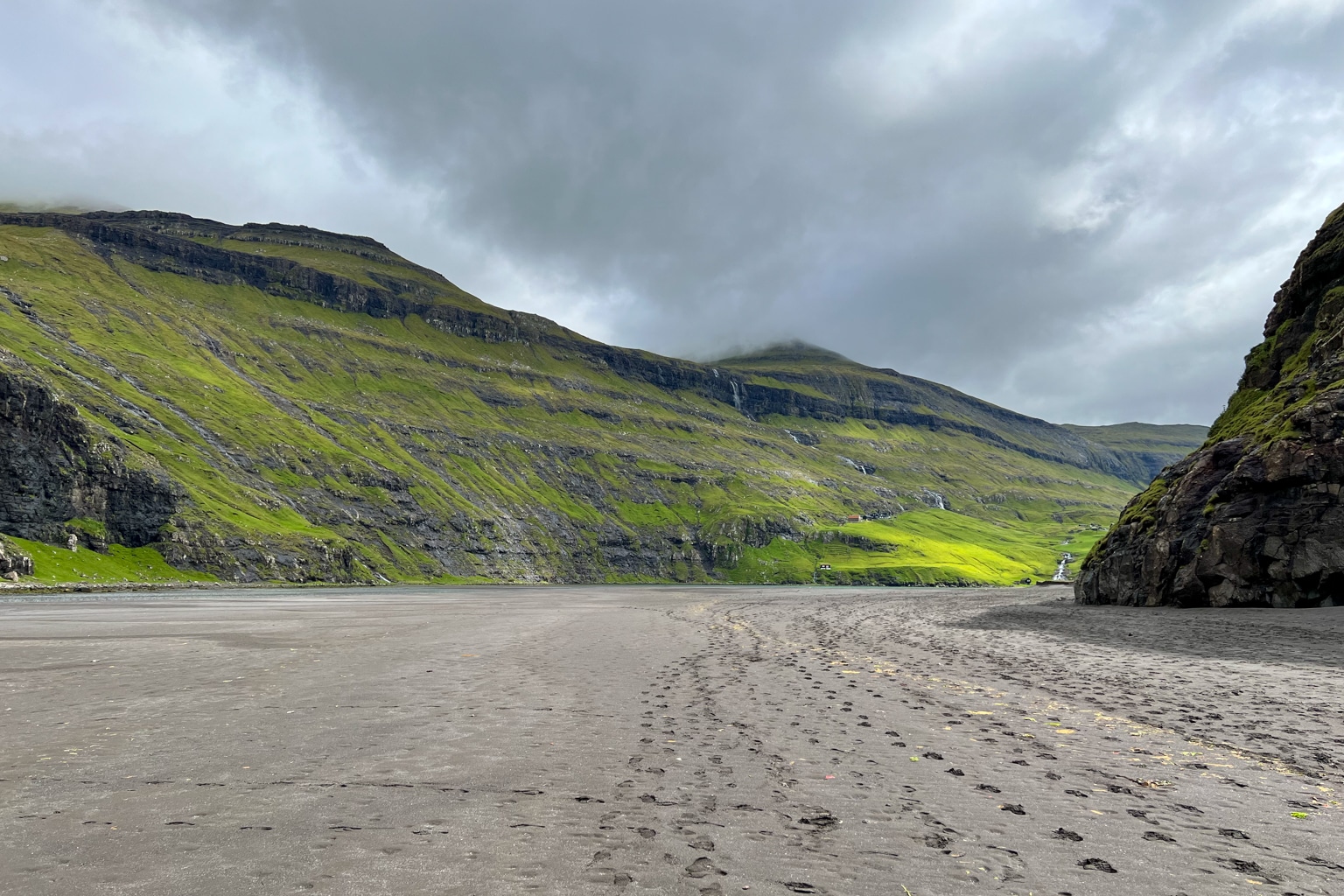
Another is the village of Gjógv, located at the very northern tip of Streymoy, where you can hike up another pure-green hillside and take in similar views to over at Kalsoy.
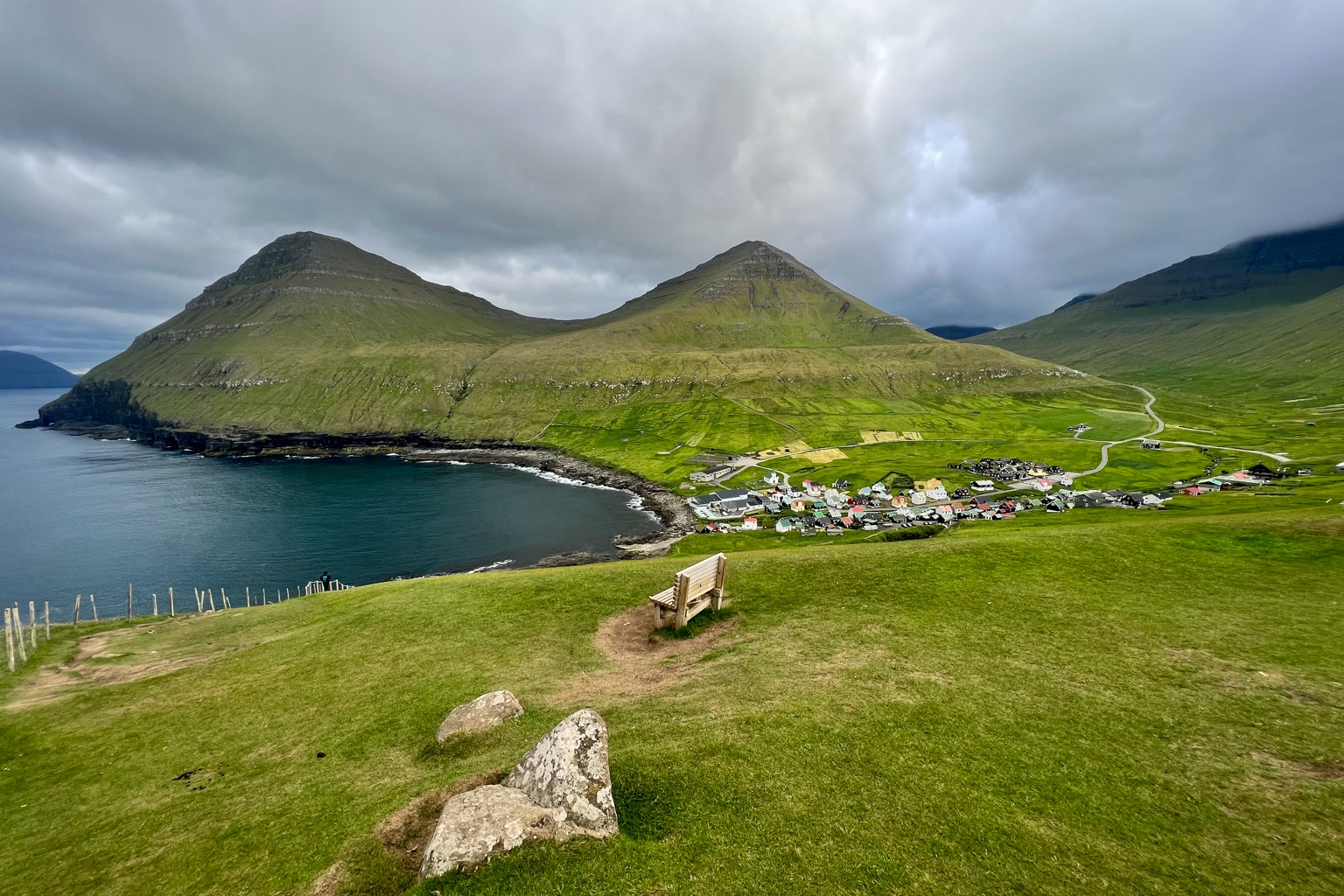
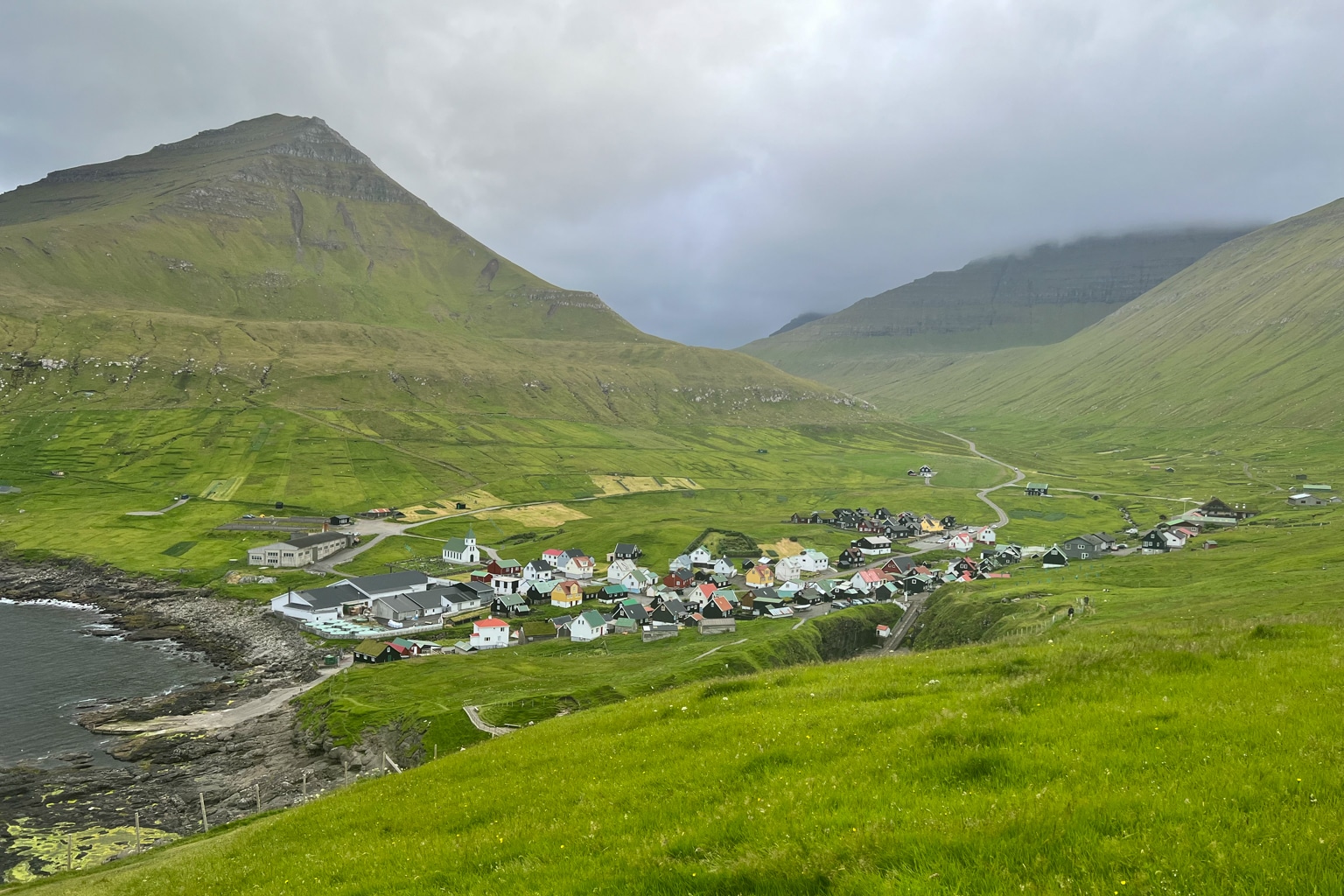
Casting your gaze eastward from Gjógv, you’ll look directly across the channel and see the northern tip of Kalsoy.
If you happen to visit Gjógv after hitting up the Kallurin Lighthouse, and you find yourself missing those unbelievable views over there, you’ll get another taste and a different perspective of a truly life-changing vista.
Of course, it’s not just the villages here on Streymoy, which are easily accessible from Tórshavn, that are worth checking out.
Rather, a lot of the villages in the outer reaches of the Faroe Islands are worthy of your time as well…
6. Go for a Helicopter Ride
While any helicopter ride is certainly going to be a highlight, taking one in the Faroe Islands definitely ranks among my most favourite travel experiences.
As an important transport link between the islands, helicopters can be booked at a significantly discounted rate for locals. Visitors to the islands may also book available seats, but only on a one-way basis.
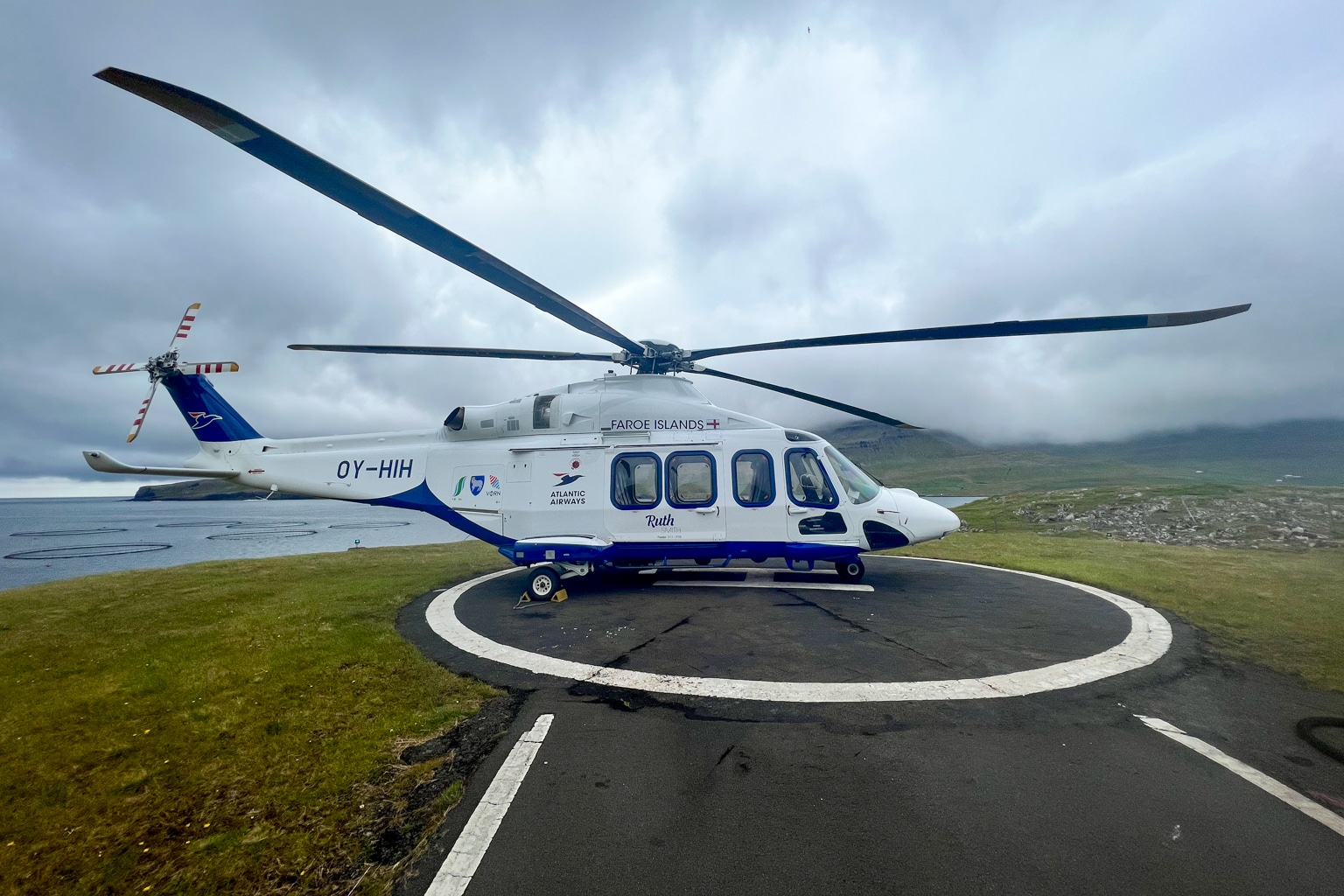
You’ll have to book seven days in advance, or two days in advance for specific routes. And even though you can book a ride in and out of Tórshavn, I would recommend taking a ride between two of the outlying islands so you have an excuse to go check out more places.
That’s exactly what I did, taking a ride between the southernmost island of Suðuroy and the tiny settlement of Skúvoy, with a stop on the tiny but beautiful island of Stóra Dímun.
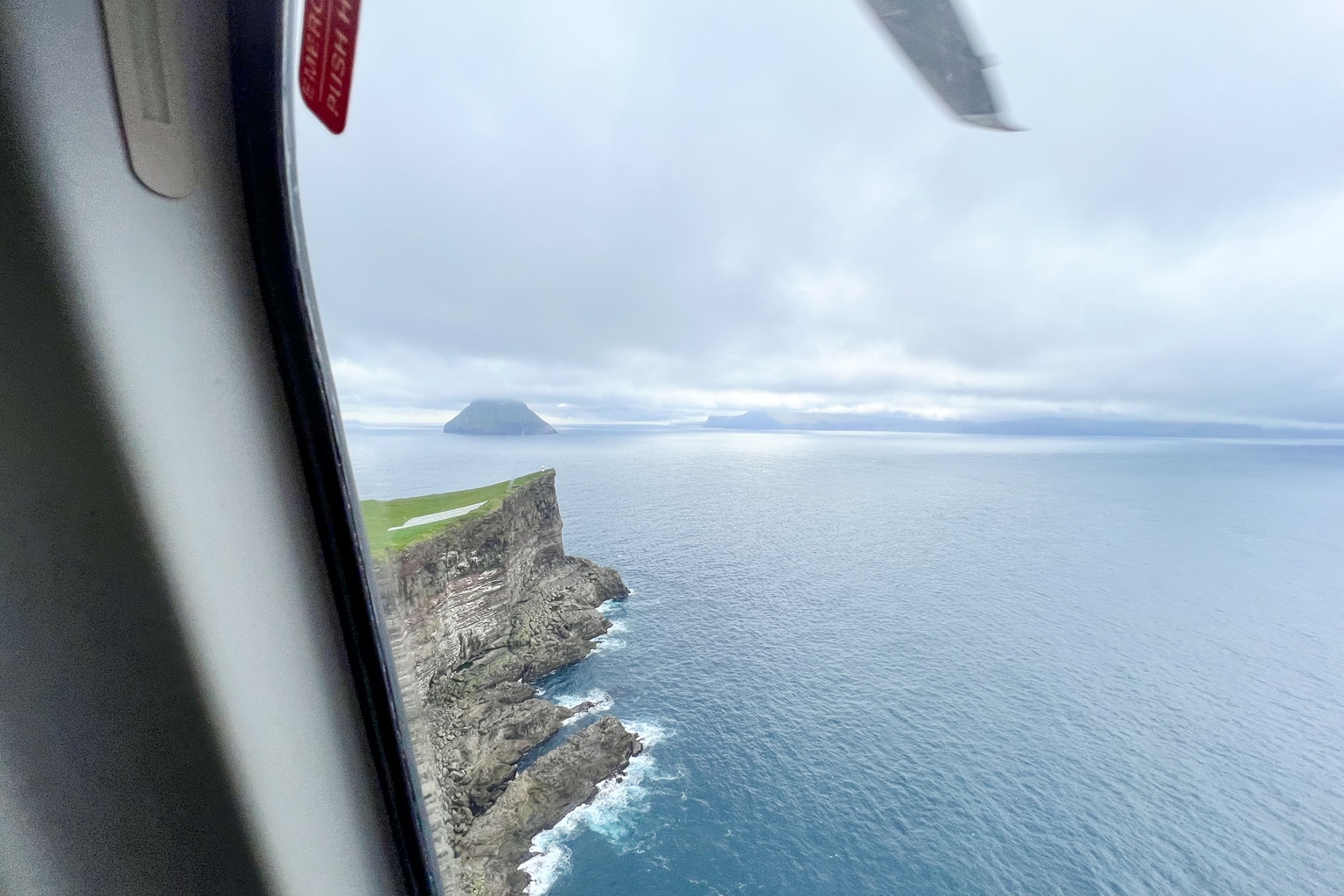
A helicopter ride can be booked online at amazingly low rates, and my journey only cost 85 Danish krone ($15 CAD) – a spectacular deal for an aviation experience with aerial views that you won’t find anywhere else.
7. Take a Day Out on the Ferries and Buses
Part of what contributes to the surreality of the Faroe Islands is the fact that it’s extremely remote, and yet the infrastructure is extremely well-developed.
As part of the Kingdom of Denmark, they’ve had the funds to develop a very well-run public transportation system, which allows you to explore the islands comprehensively even without access to a car.
For example, after my helicopter ride to Skúvoy, I took the ferry from this tiny island to the port of Sandur on the island of Sandoy.
From here, I took a bus that operates exclusively on Sandoy, going from Sandur to the northern point of the island: a town called Skopun.
And from Skopun, I then took a ferry to Gamlarætt, back on the island Streymoy, and then I took a final bus back to Tórshavn.
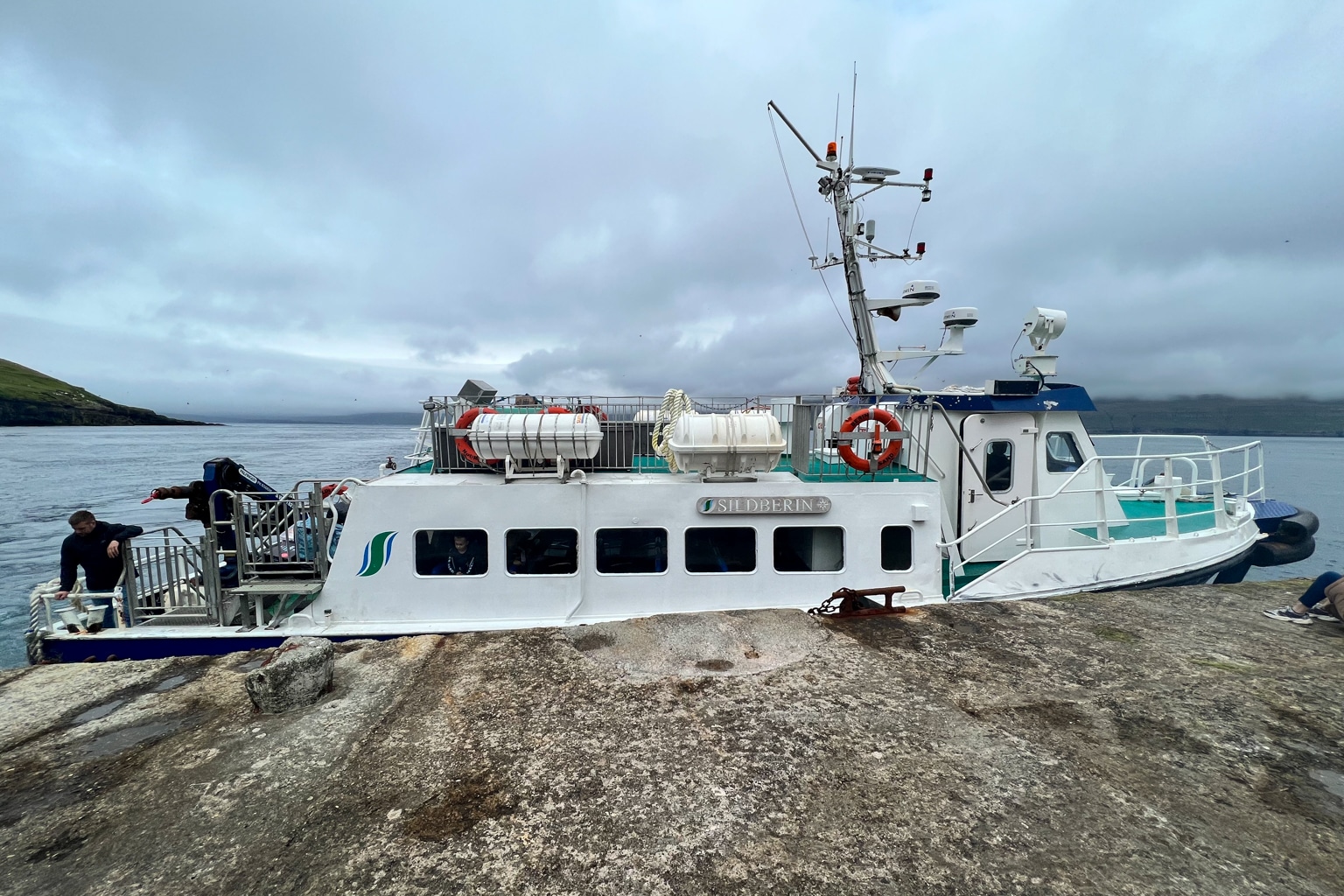
The fact that all of these bus and ferry schedules line up very well is really quite remarkable. If you have a day to spare, I’d recommend leaving the car behind and going about the outer islands on ferries and buses to get to know the Faroe Islands from a different angle.
Note that by 2023, the Faroe Islands plan to build a long tunnel down to Suðuroy, which may phase out the need for ferries along large parts of my journey.
While this will significantly shorten travel times for inhabitants of the outer islands, I’m a bit sad to learn that certain ferry routes may no longer be available the next time I visit.
If you want to experience the ferries to their fullest, it’s best to plan your visit to the Faroe Islands sooner rather than later.
8. Experience the Humble Hospitality of the Faroese
The Faroese are hard-working, trouble-free, and humble people who are just happy to occupy their little fairytale slice of our beautiful planet. It’s certainly worth chatting with a few of them to get a sense of what it’s like to live out there.
On our trip, we decided to hitchhike for the first time ever on the island of Suðuroy as we were trying to get between the ferry terminal and the heliport.
(We had originally planned to walk the distance, but since we discovered we were pressed for time, we had no choice but to turn around and stick out our thumbs.)
Luckily, we were picked up by a lovely older couple, who very warmly welcomed us into their vehicle and happily gave us a ride.
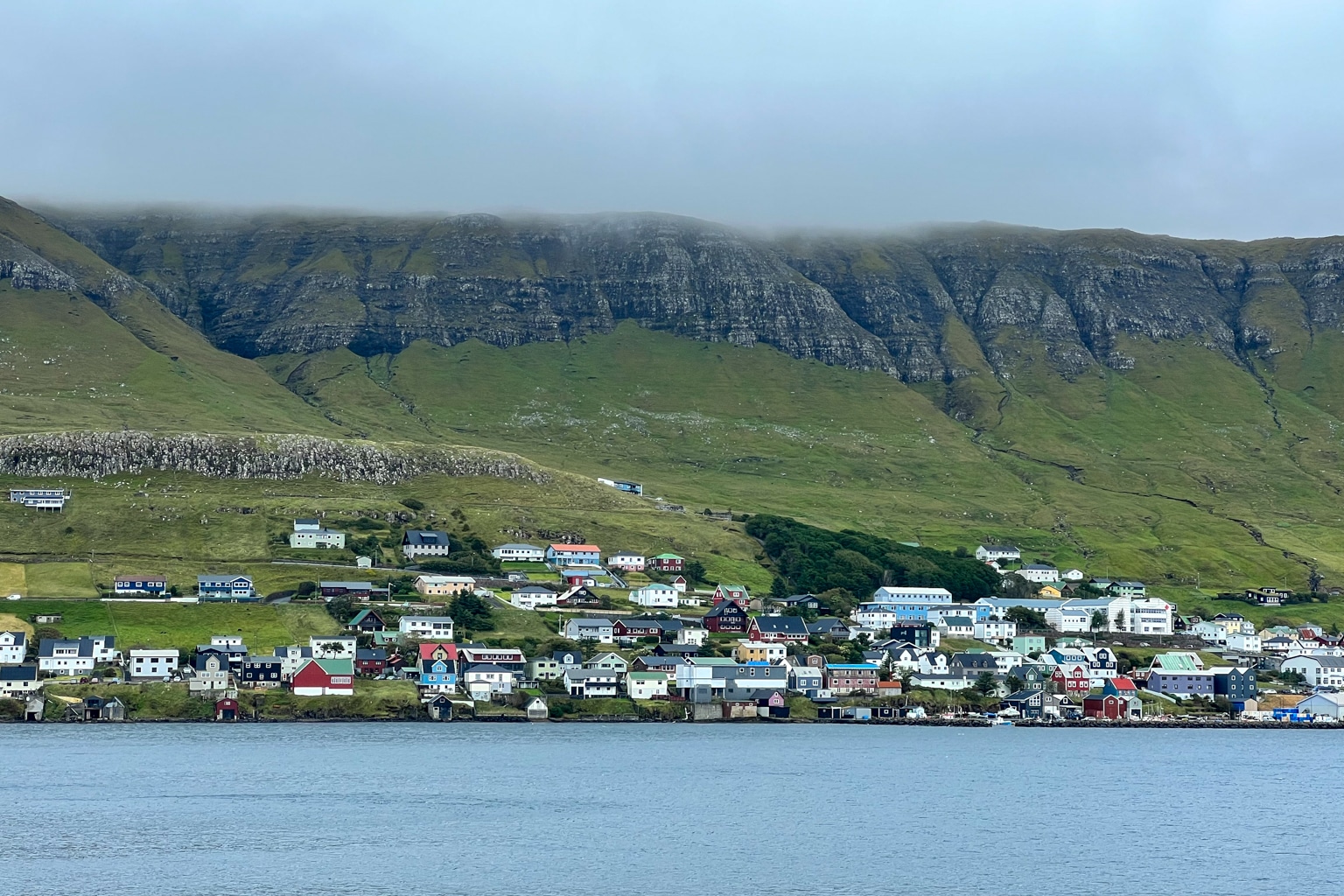
Needless to say, the couple were very curious about what we were doing out here in the Faroe Islands.
You’ll find that the Faroese will be quite curious about tourists in general, as it’s not really a country that is built for tourism quite yet. Even the ferry operators would talk with us, getting a sense of where we were from and what we were doing out here.
We were delighted to make friends with this older couple on Suðuroy, and we’ll definitely be sending them a postcard of our very own beautiful coastal views from Vancouver.
9. Stay at the Hilton Garden Inn
In Tórshavn, the Hilton Garden Inn is an excellent home base. While it’s located outside of the city centre, I would consider this a plus, as its location gives you the chance to enjoy a nice stroll to Tórshavn’s core.
It’s also really easy to get on the highway from here, especially en route to some of the more northern destinations on Streymoy and beyond.

The Hilton Garden Inn offers great value for Hilton Honors points, too. The Faroe Islands tourist season is quite short and hotel rates are usually elevated, so you can get an excellent deal here by redeeming Hilton points.
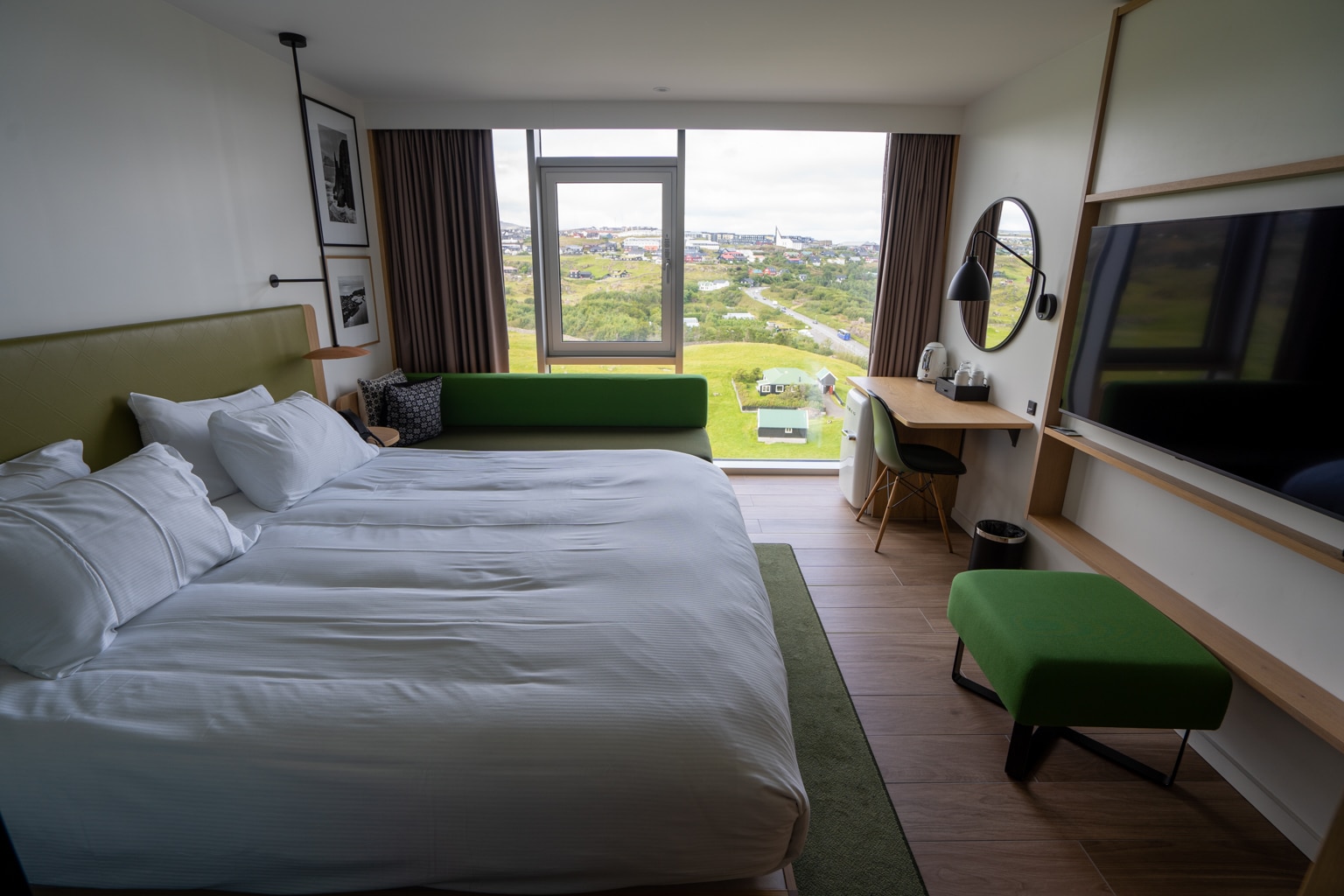
While I enjoyed my stay at the Hilton Garden Inn, part of the Faroe Islands experience that I would’ve also liked to have was to spend time at an Airbnb or guesthouse on one of the smaller islands.
I’ll definitely be seeking that out on my next visit to the Faroe Islands, especially since there’s something of a “gotta catch ‘em all” element to see as many of the 18 islands as possible.
10. Spot Puffins
Lastly, you’ll want to spend time with the adorable puffins of the Faroe Islands.
You’ll be able to spot them all over the islands, whether they’re just swimming in a pack off the coast of Skúvoy or occupying their nesting holes on the cliff side of Múlafossur.
If you’re into photography, the puffins can be a wonderful subject to pursue and capture, especially against such a unique natural backdrop.
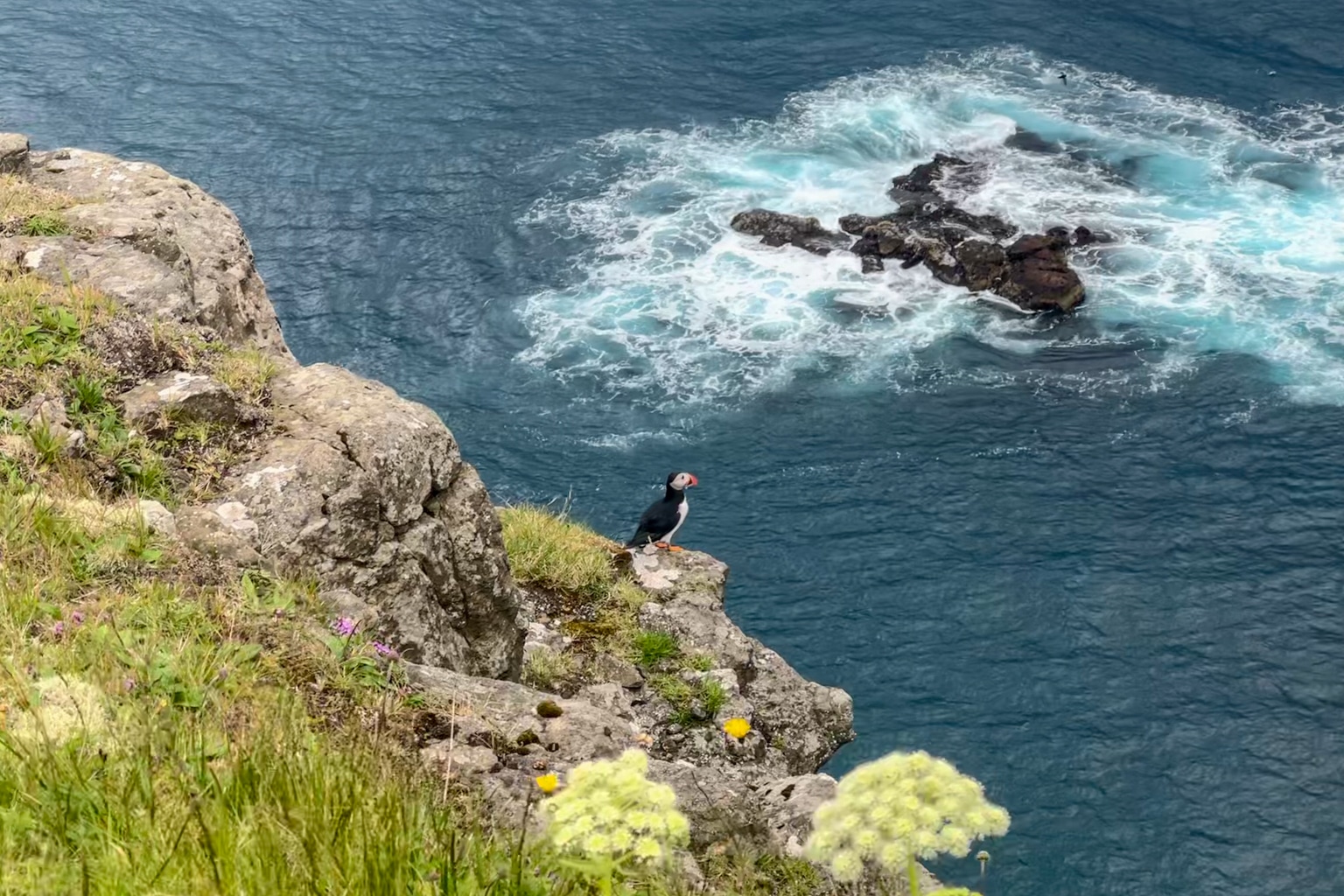
Just like in neighbouring Iceland, puffins are a unique element to Faroe Islands, and are well worth spotting as you take in all of the natural beauty.
Conclusion
My visit to the Faroe Islands was one of the most transformative trips I’ve taken in recent memory, especially after two years of limited travel and a lack of invigorating new destinations to discover.
From walking around the capital of Tórshavn to discovering all corners of this remote archipelago by car, ferry, and helicopter, from hiking up awe-inspiring cliffs to connecting with locals in remote picturesque villages, the Faroe Islands are truly a destination like no other.
Three days here was both exactly what I needed and also not quite enough time. I’d love to go back in the future, and would highly recommend that many of you go and experience this undiscovered part of the world as well.


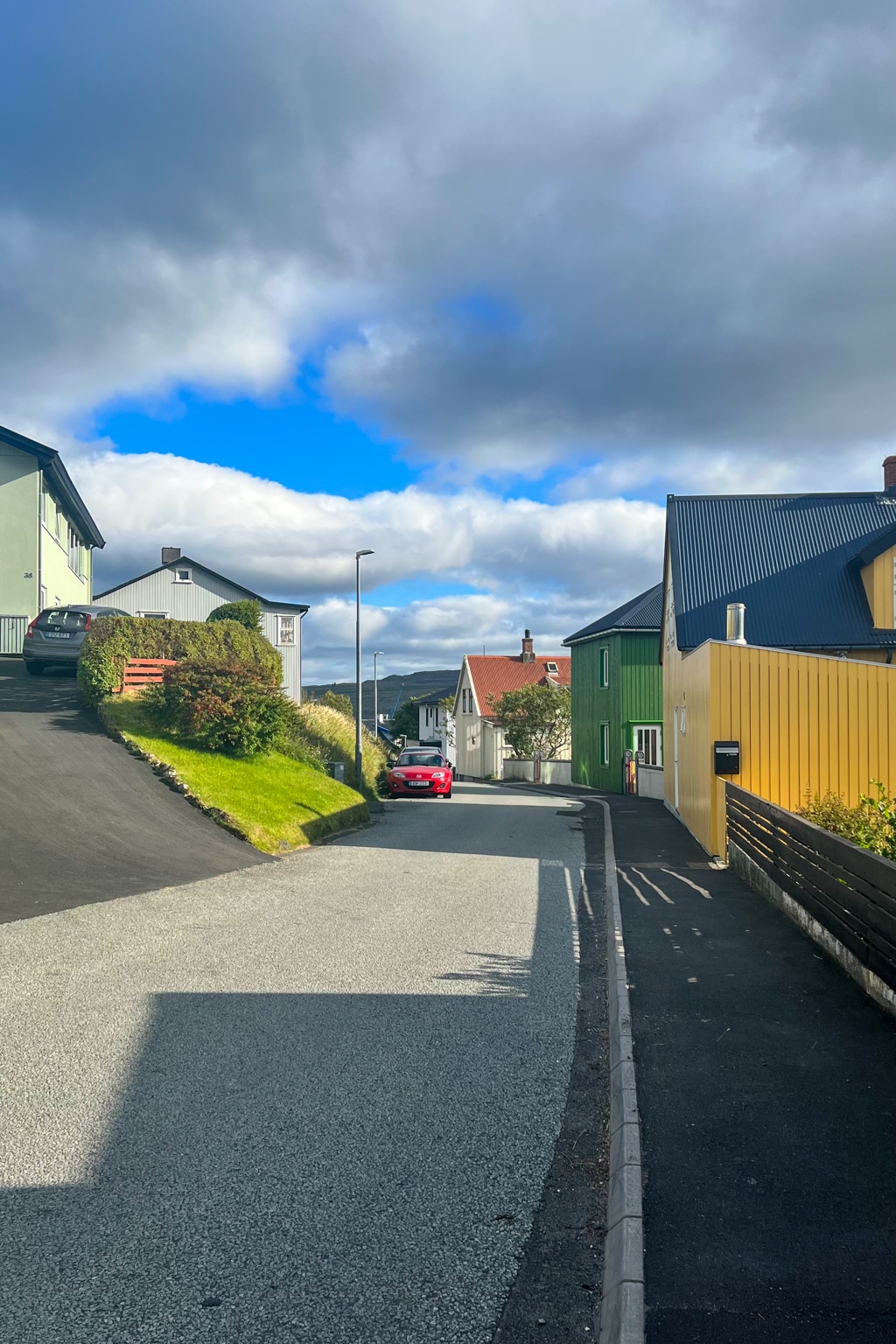
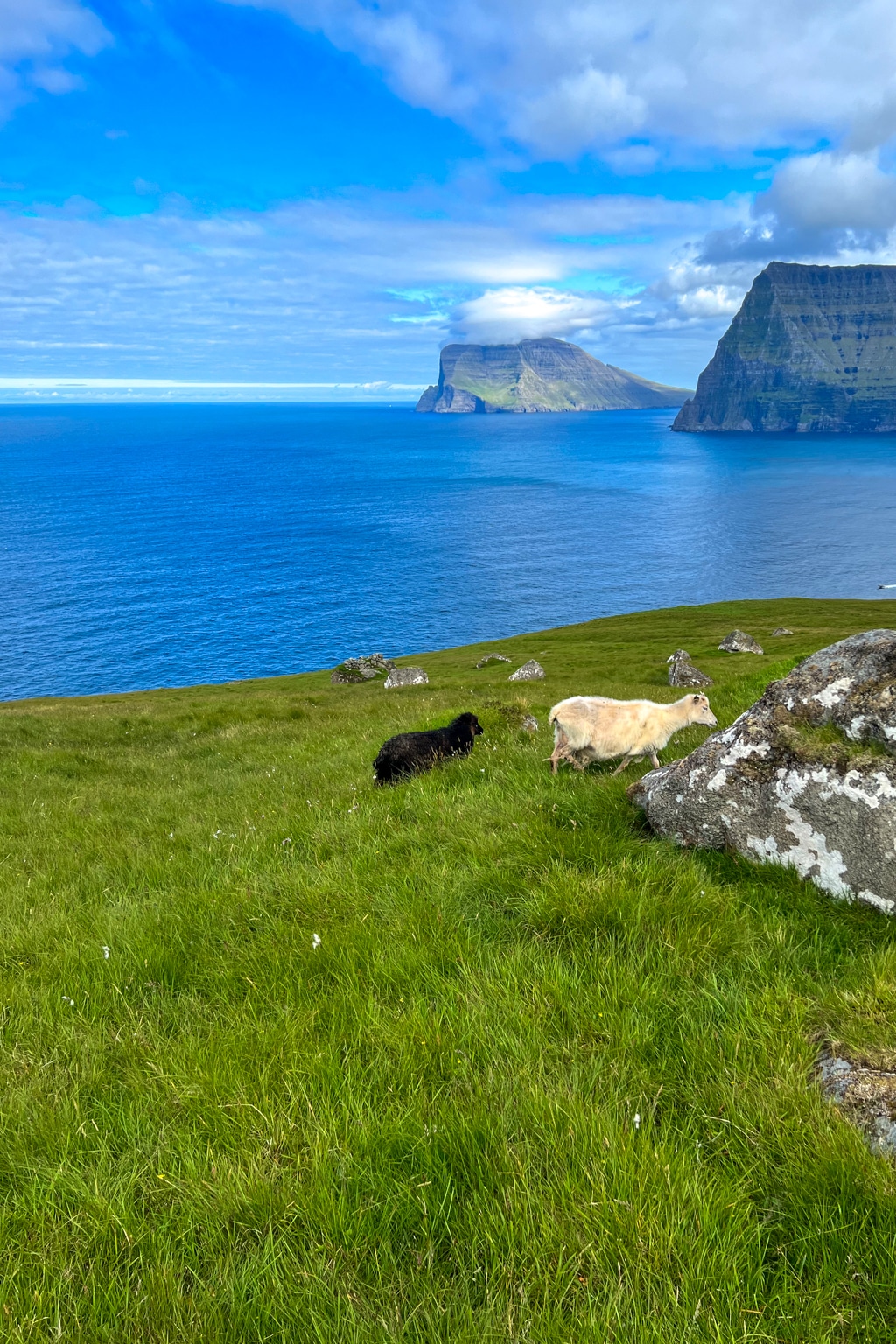
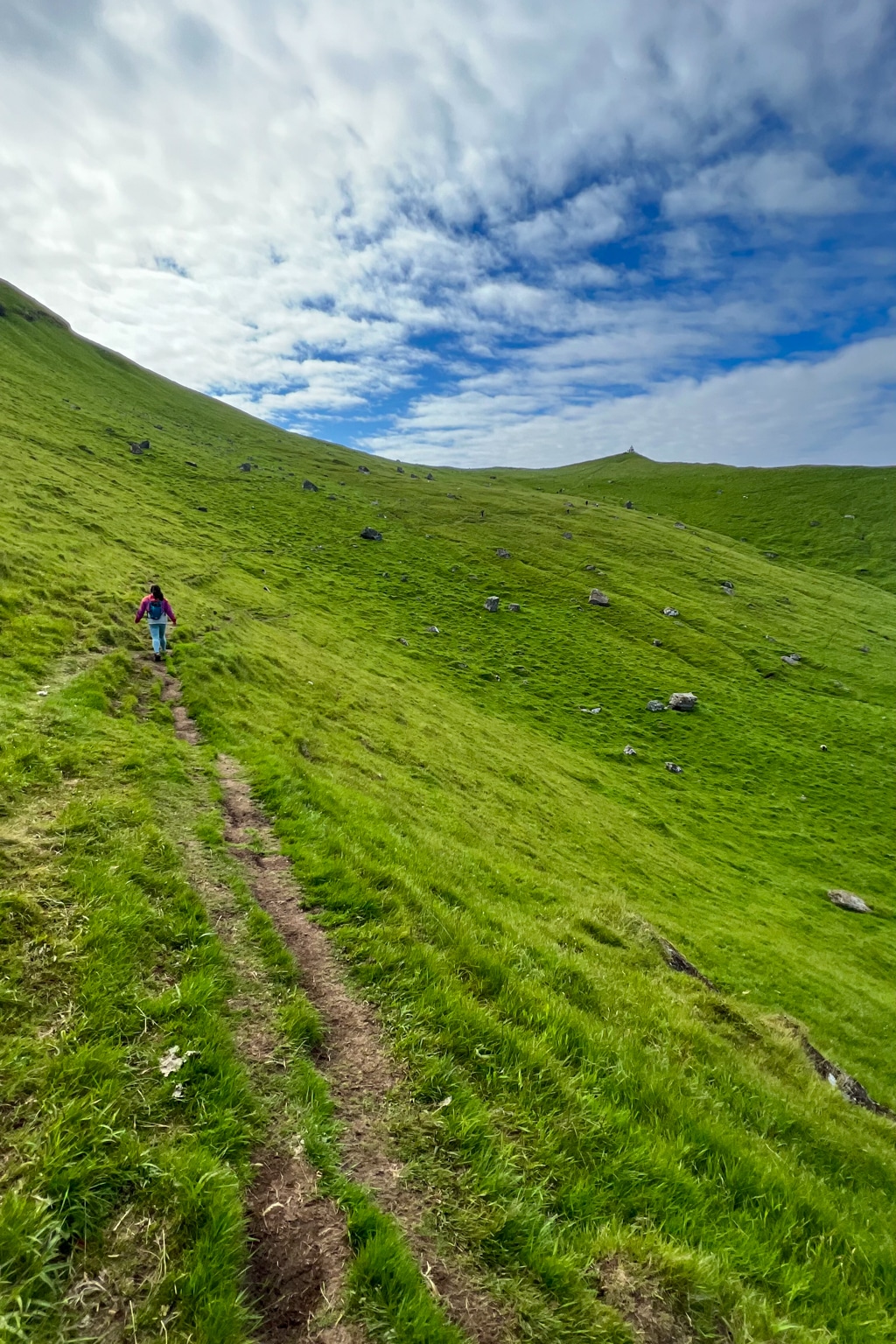
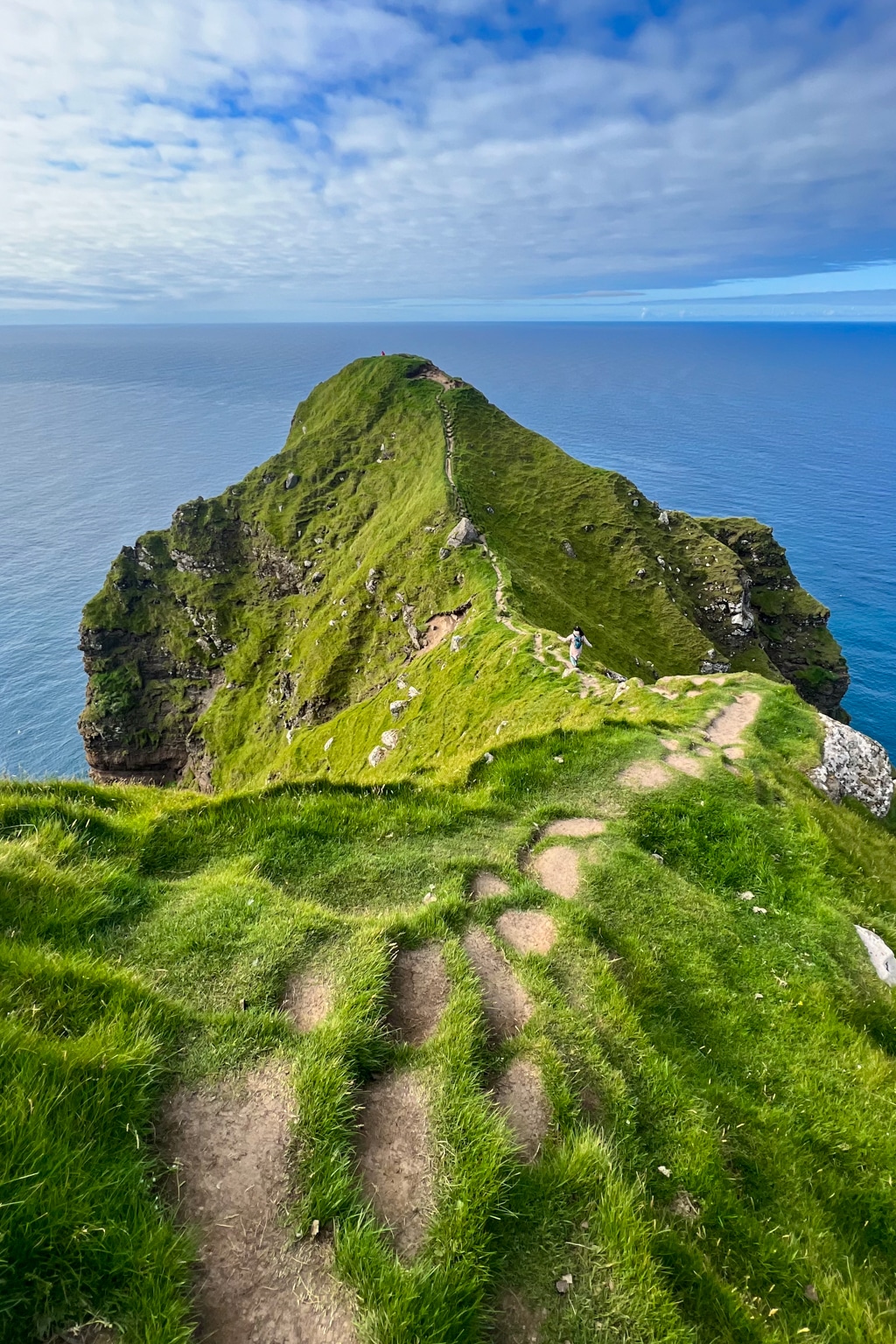
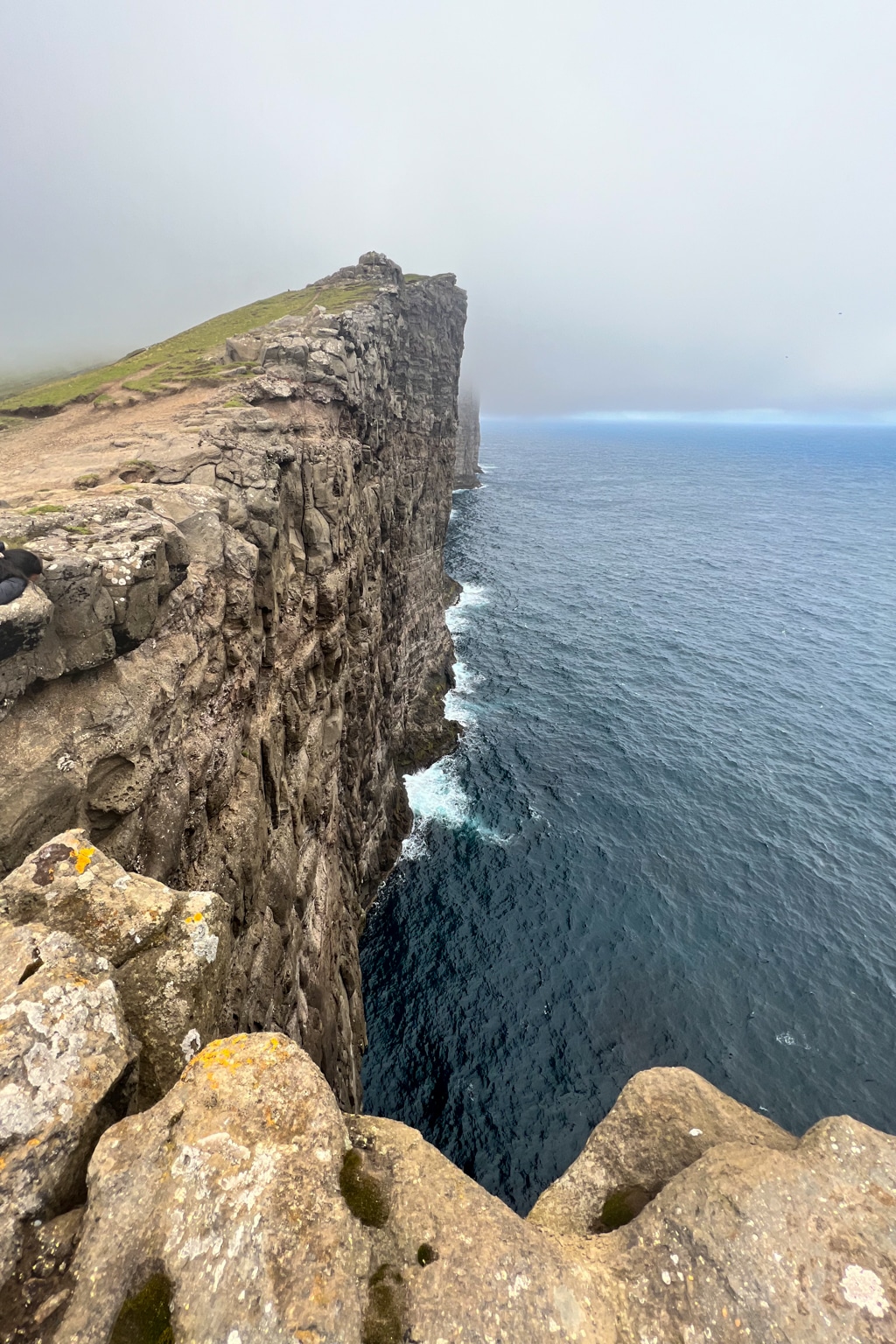
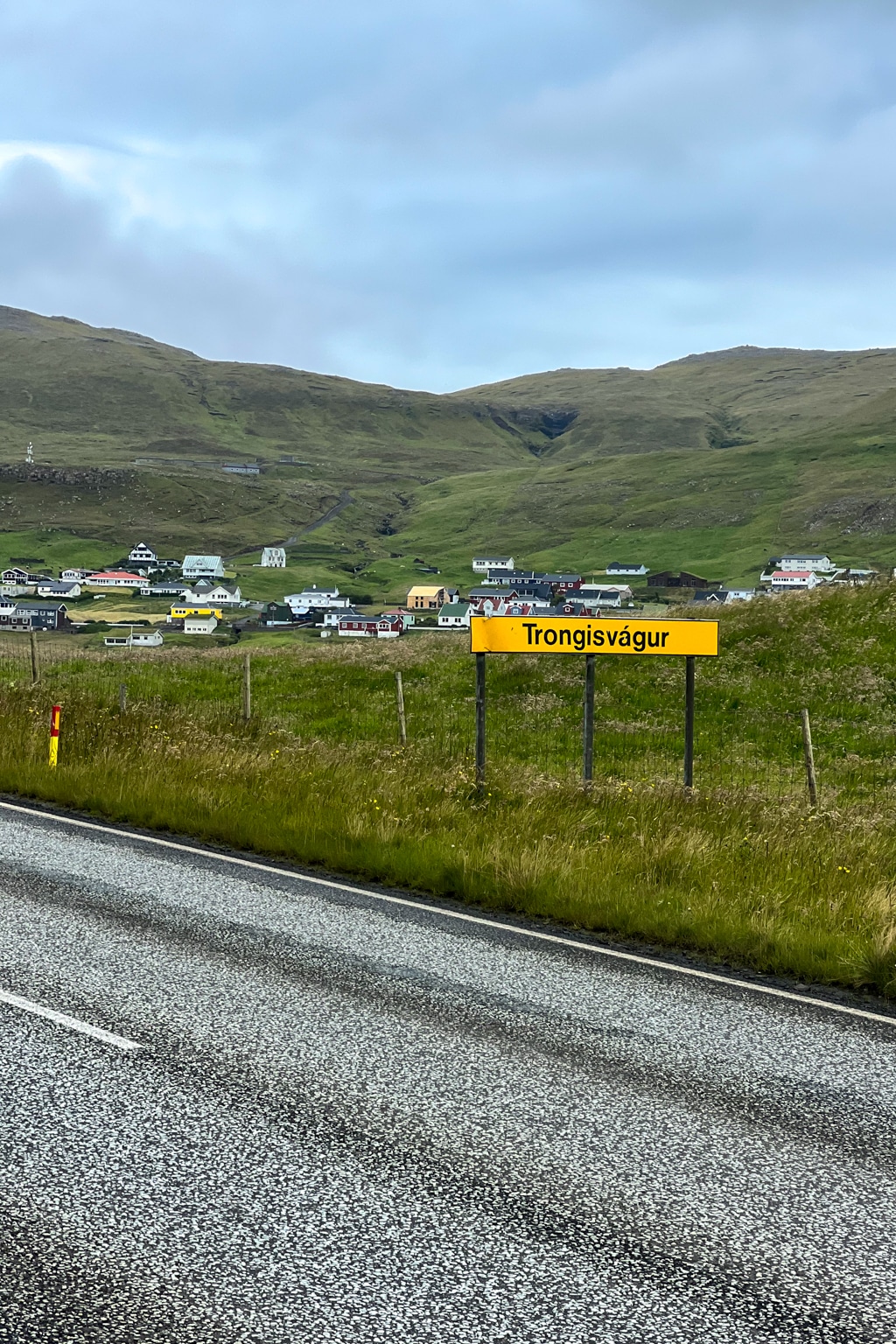
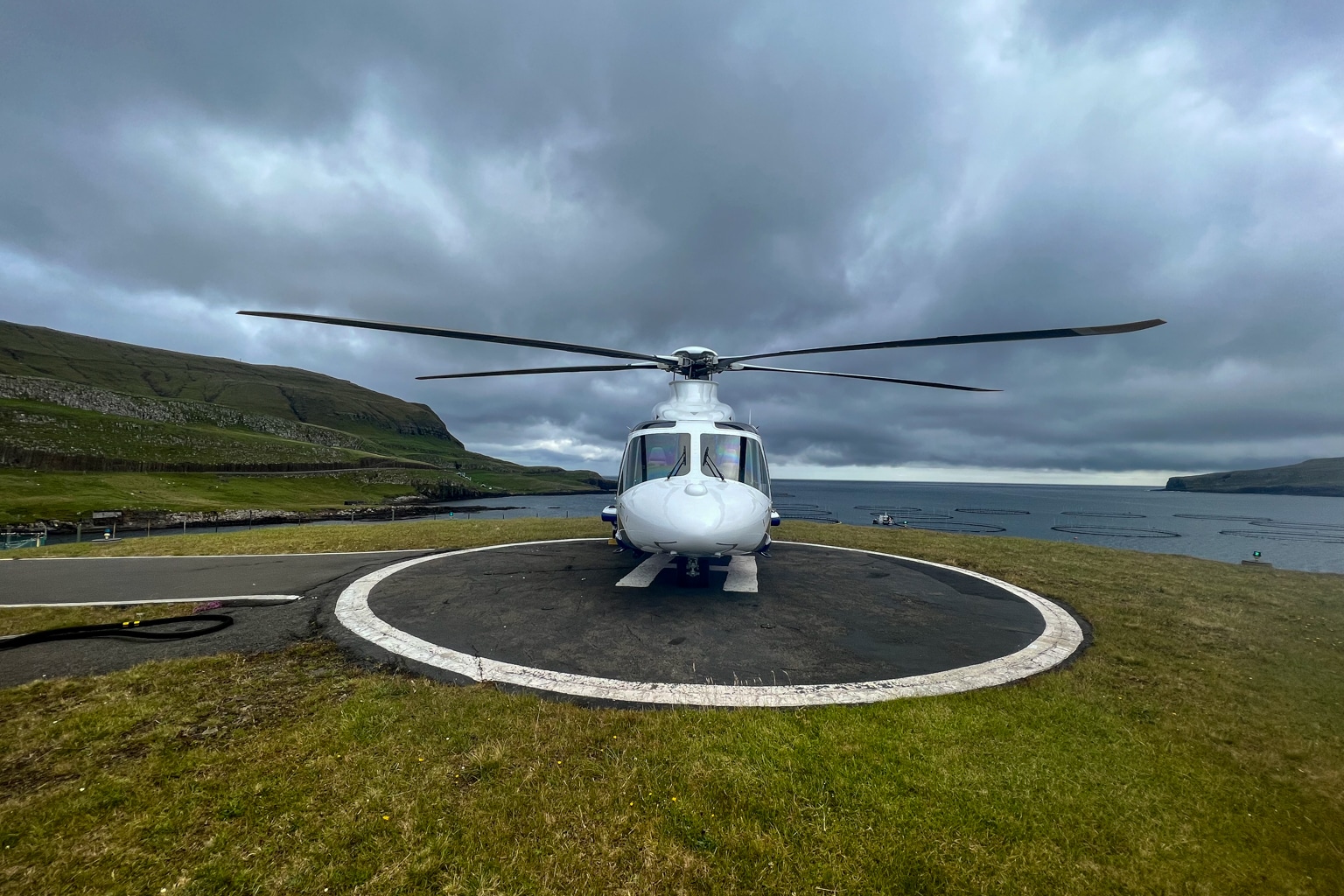
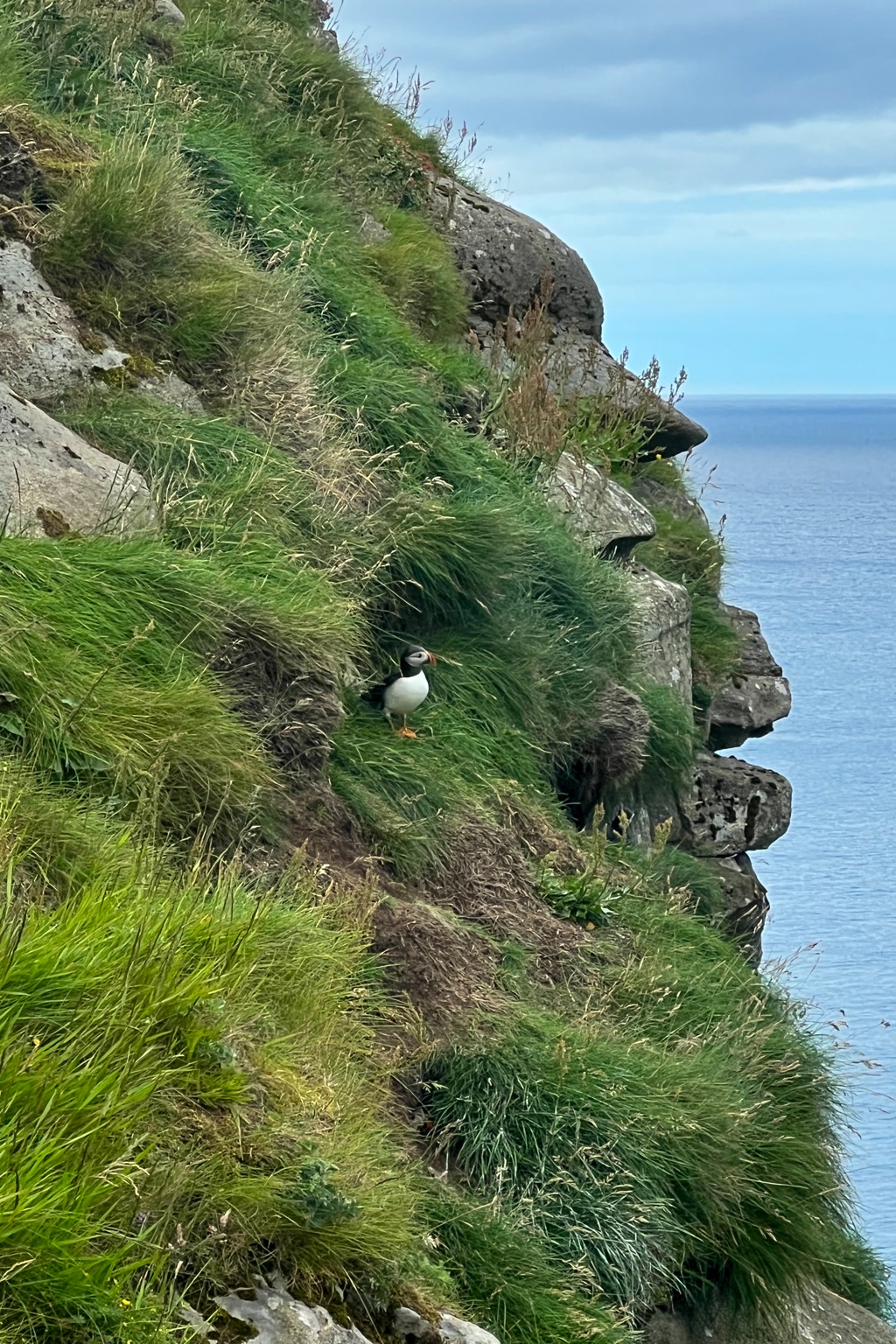
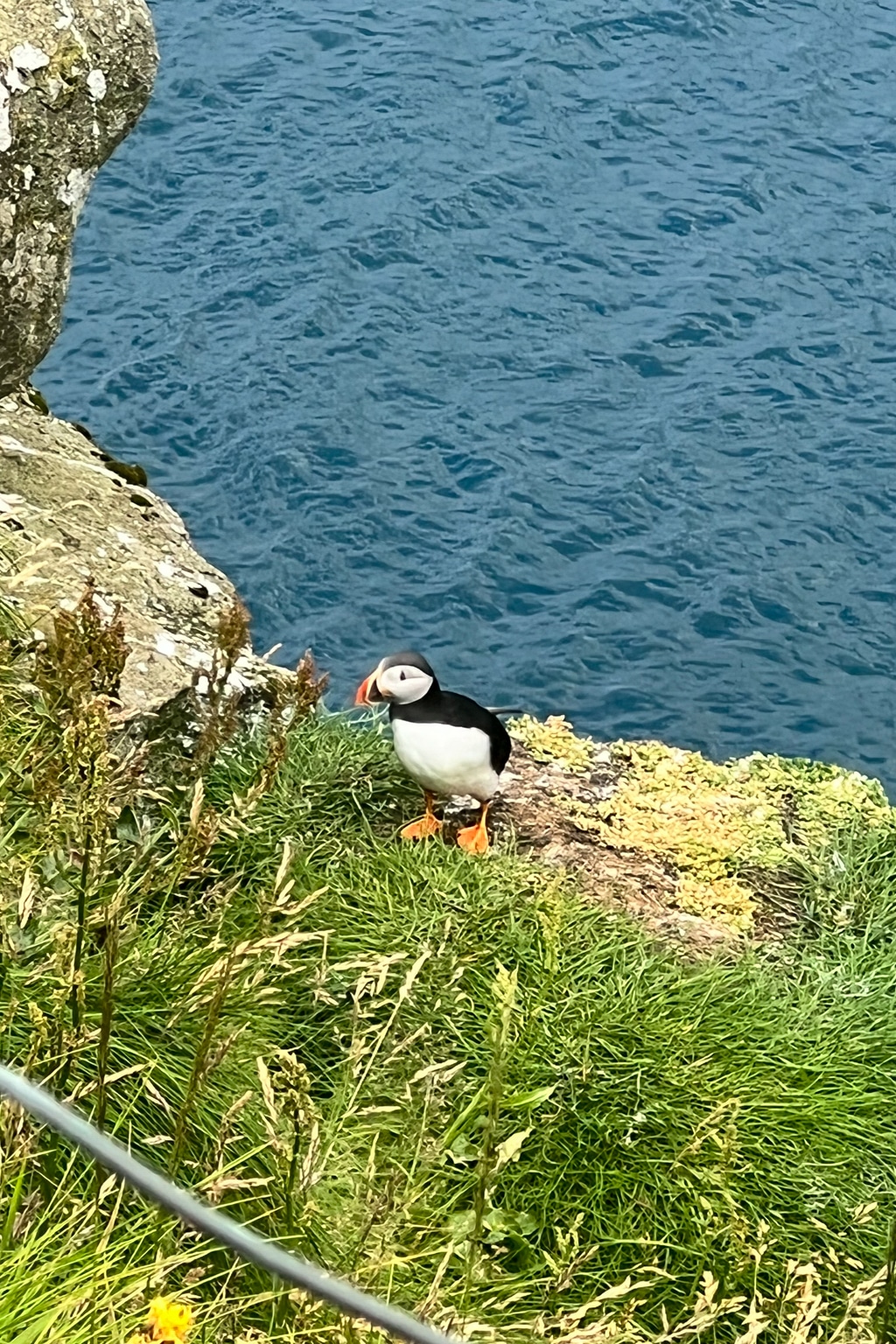













Four additional points:
1) make sure you book your accommodations before you book flights. There is limited accommodation in the Faroes, and your desired accommodation may not be available.
2) We had great success using 62N, a local travel agent, who found us marvelous accommodations and good deals on car rentals.
3) if the cafe at Guesthouse Hugo in Sorvagur (just North of the Airport) is still open, eat there!
4) Three days is not long enough. A week is not long enough.
4) Hear hear!
Thanks for sharing Ricky. Looks and sounds absolutely wonderful!